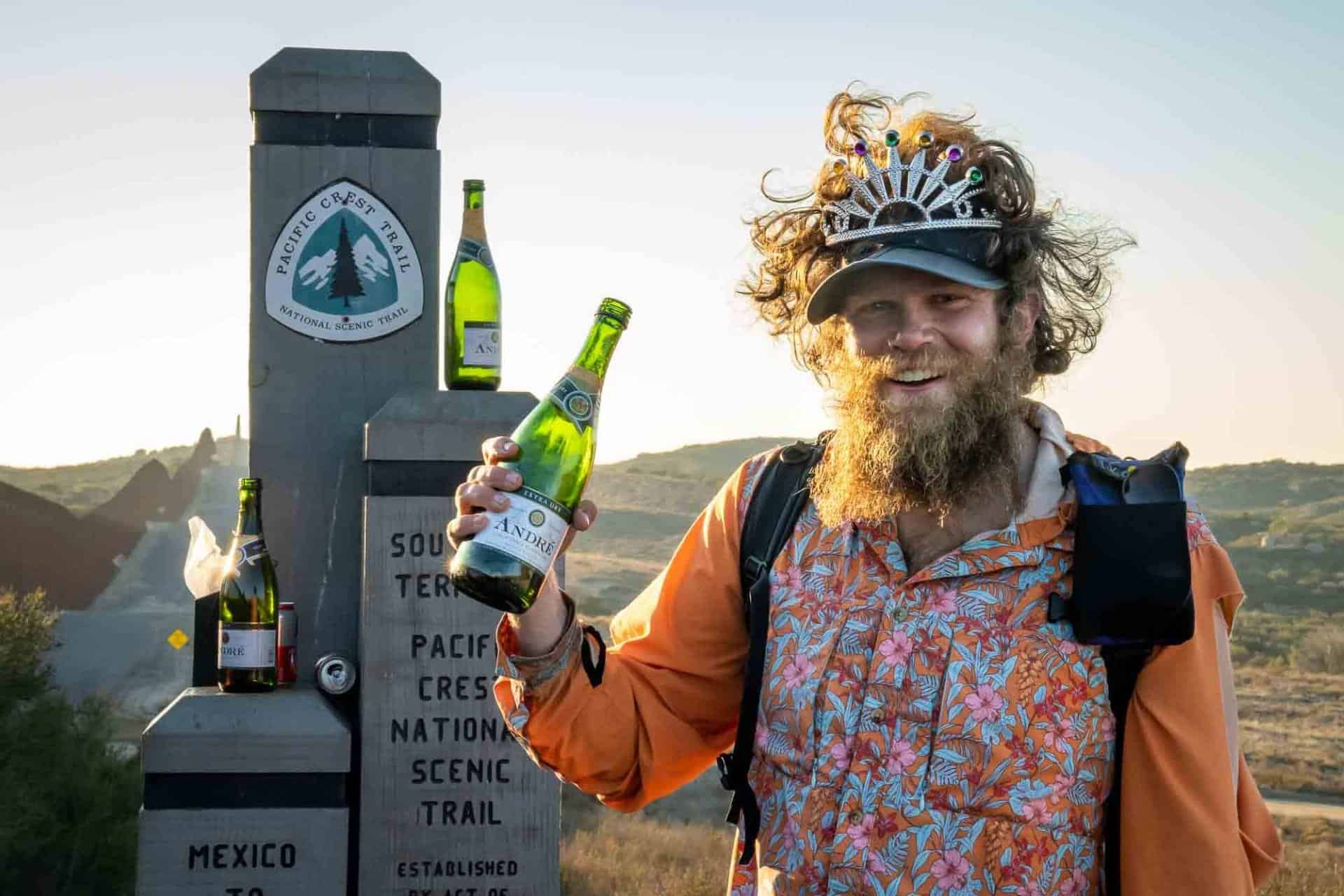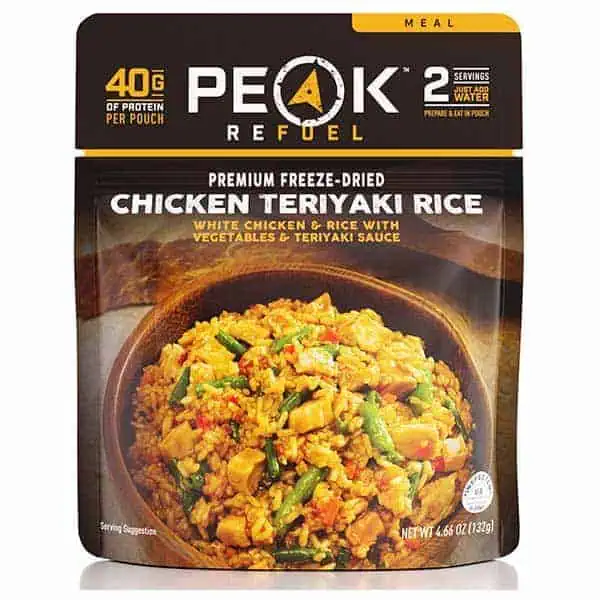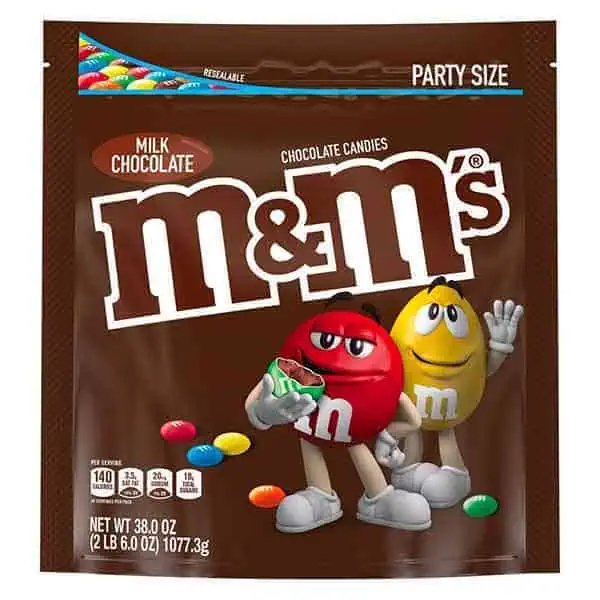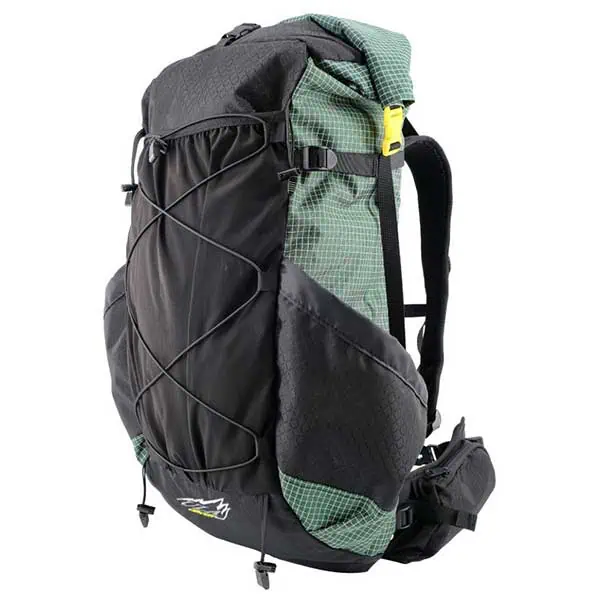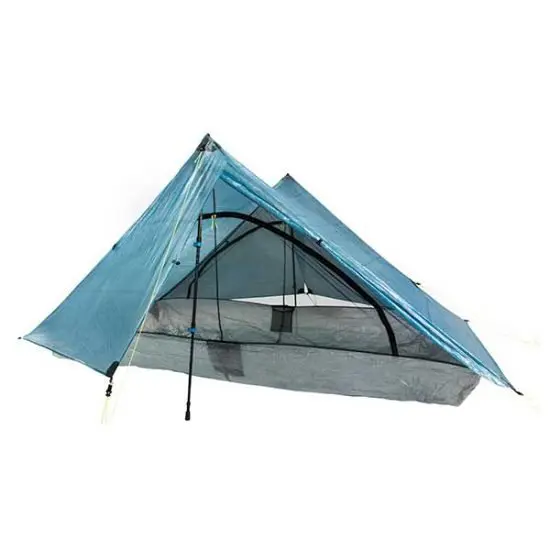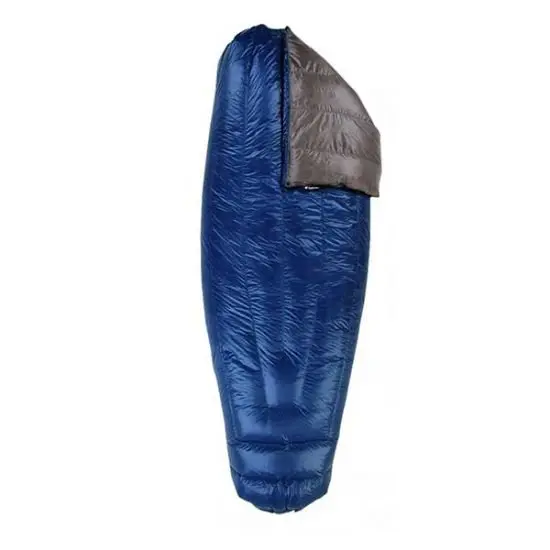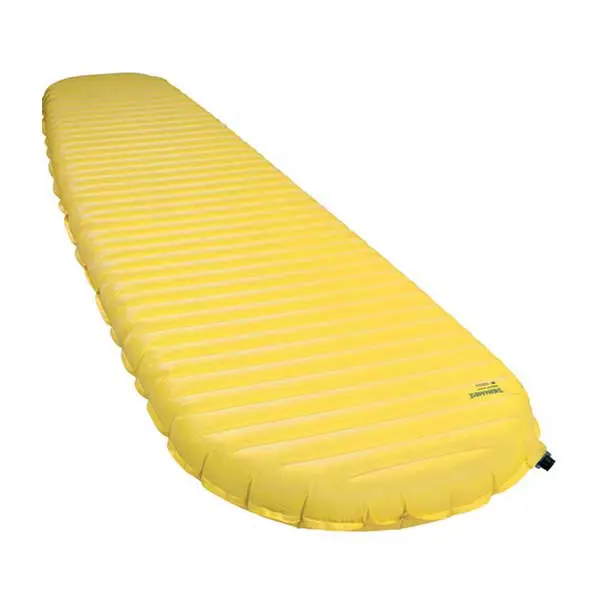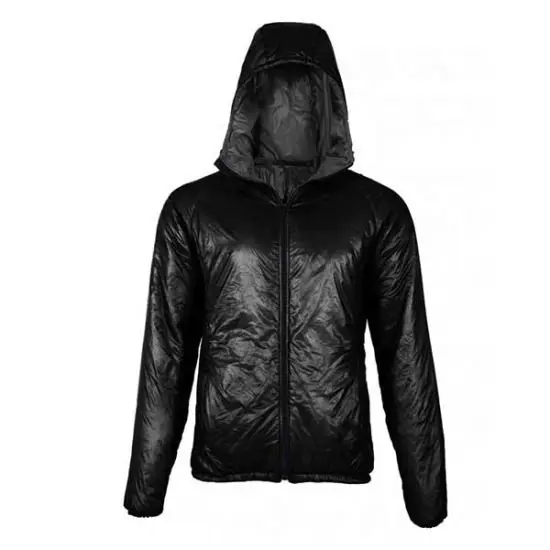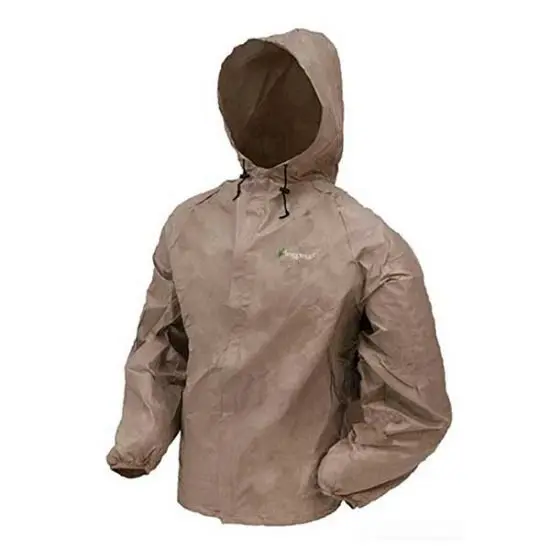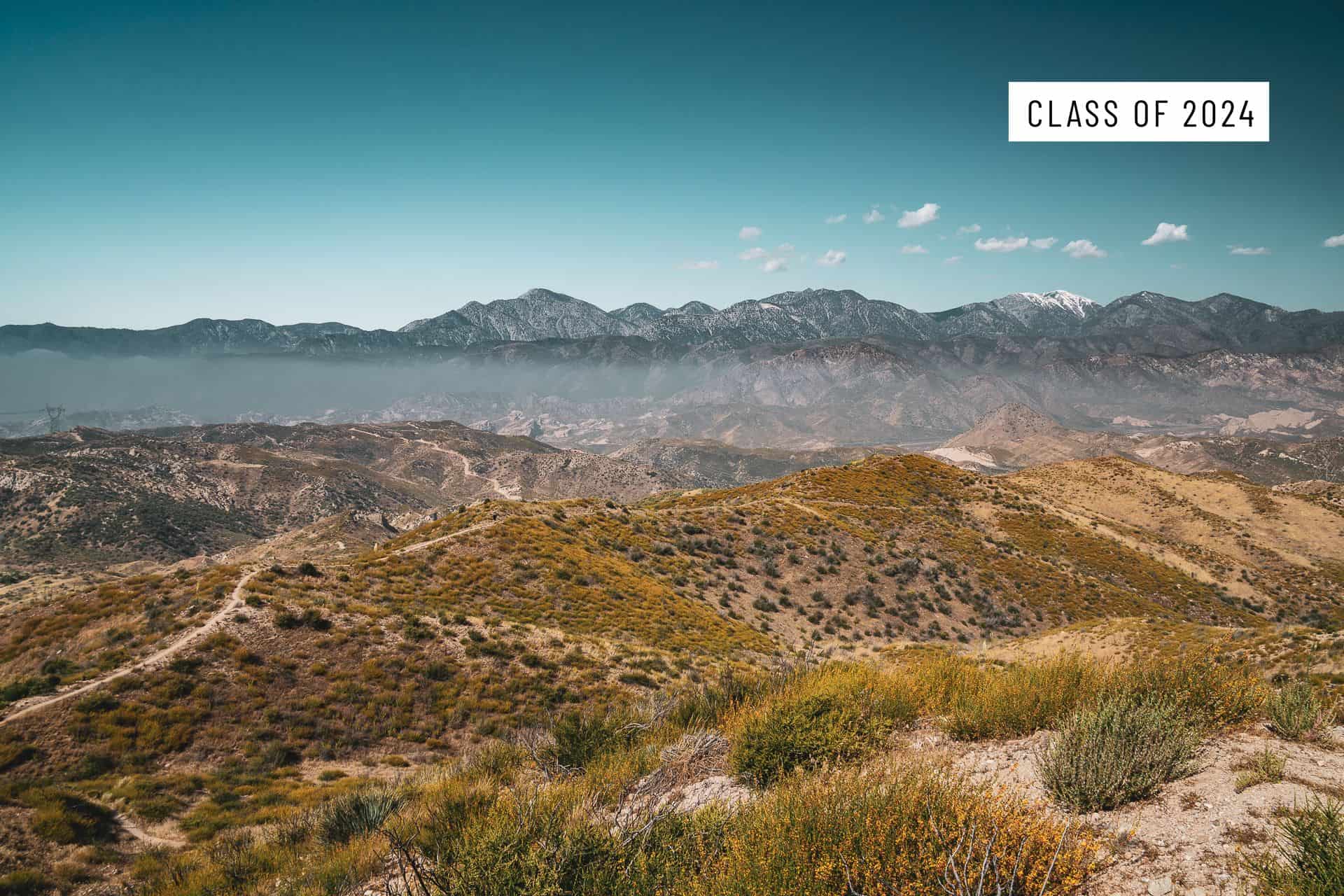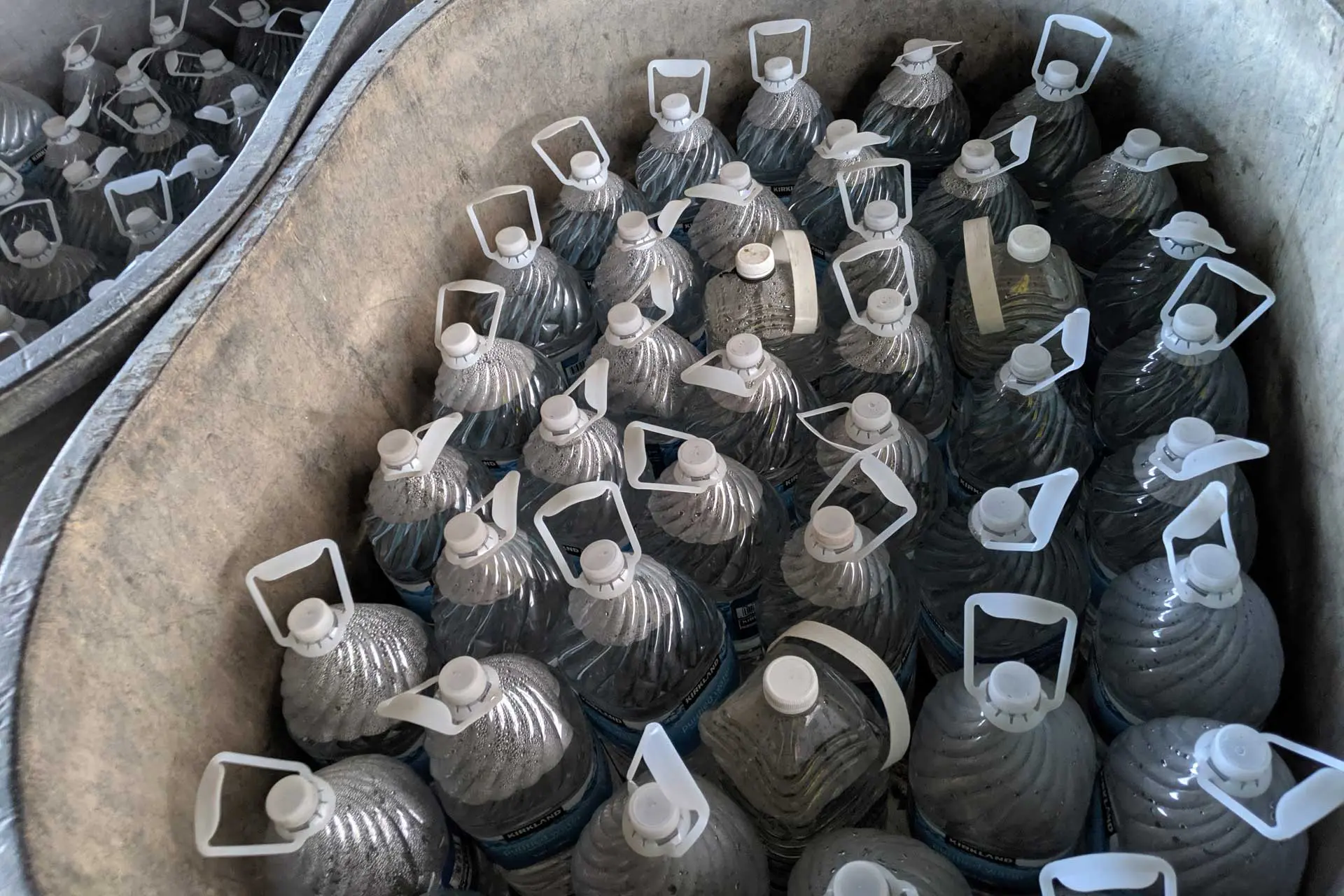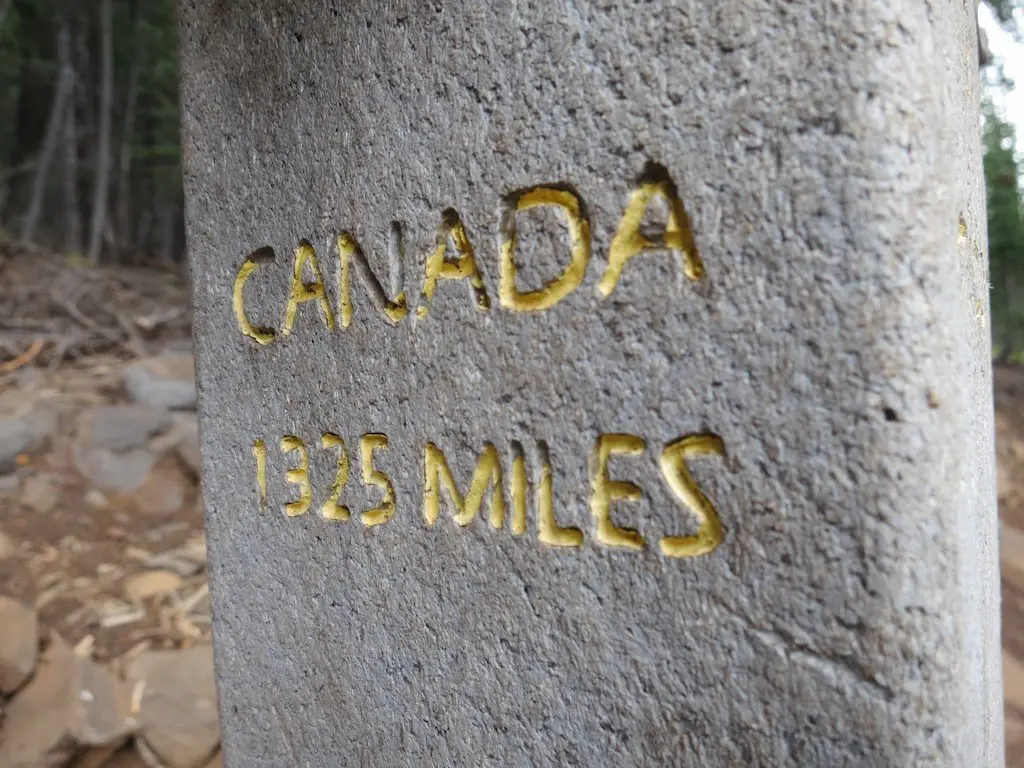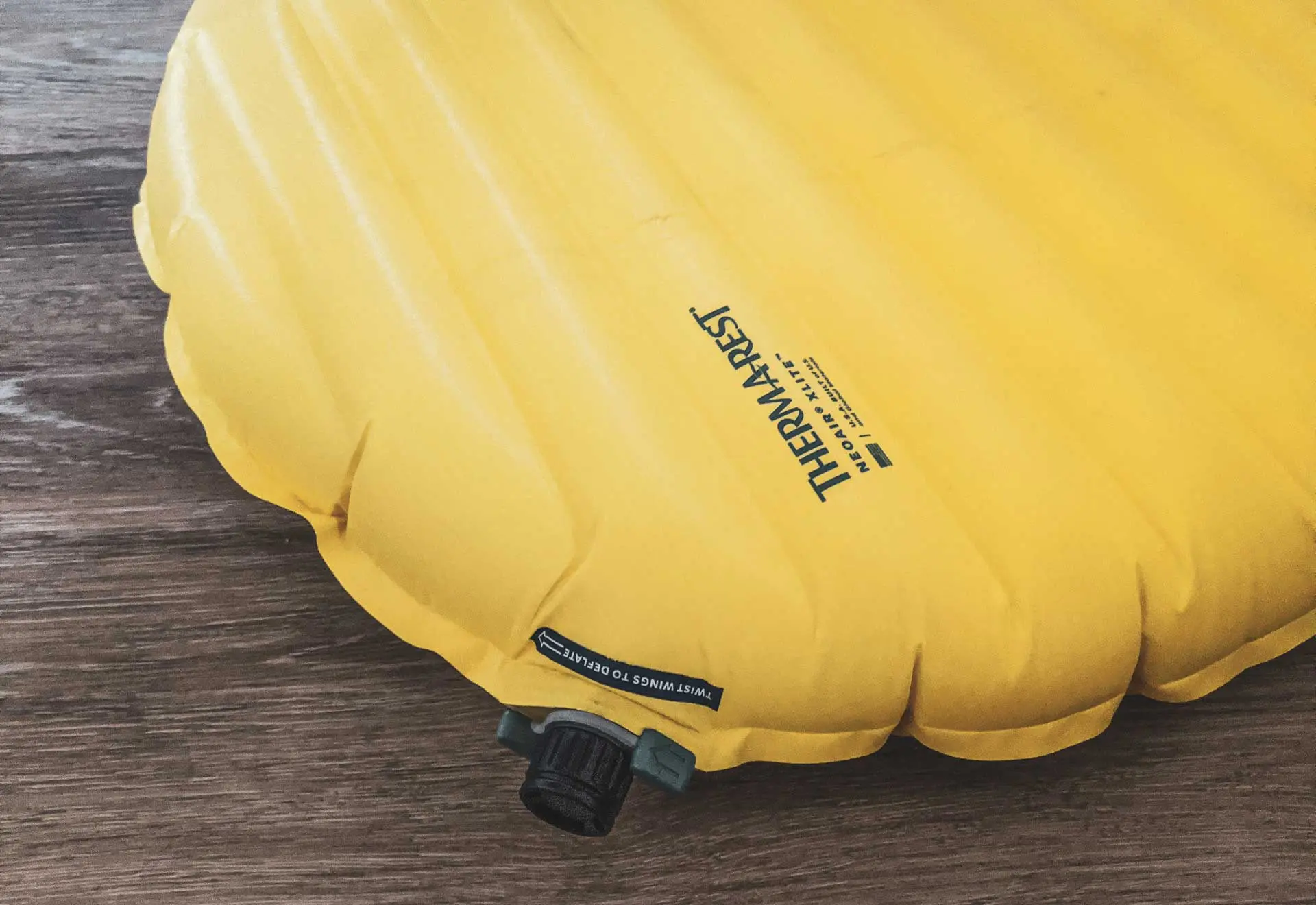Pacific Crest Trail Hiker Survey (2022)
The Pacific Crest Trail Hiker Survey is distributed to PCT hikers at the end of the hiking season every year with the goal of capturing a snapshot of the year’s class and providing a useful resource to future PCT hikers and recreators. The Survey is now in its tenth year and I would like to extend a huge THANK YOU to everyone who took the time to participate and provide feedback.
This year’s survey is the most comprehensive yet and I’ve devoted a tremendous amount of time to compiling the results. Again, the PCT Survey is meant to be a useful resource to help anyone interested in hiking the Pacific Crest Trail figure out how to approach the seemingly-monstrous journey. Every year, I try to improve the data collected and fine-tune the presentation to best help hikers. I would love to hear what you think in the comments below.
Congratulations on arriving at a spot in the PCT Survey that most readers have probably skipped. There’s a lot to cover (I’ll probably need to split this initial article into multiple posts in the future), so I won’t waste your time with any more filler. Here are the results of Halfway Anywhere’s 2022 Pacific Crest Trail Hiker Survey!
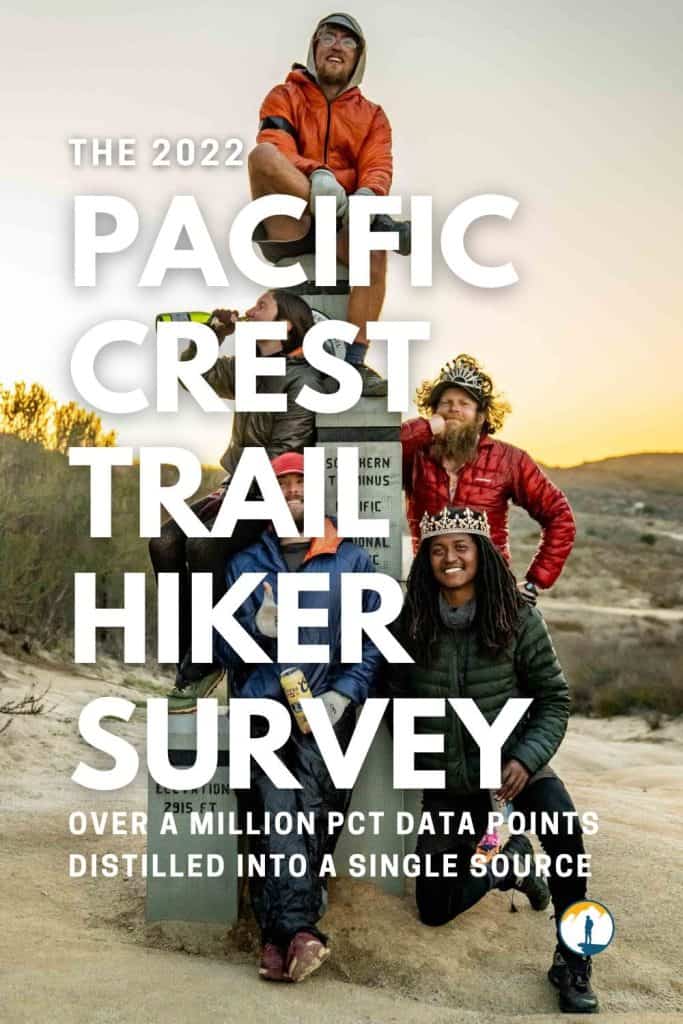
Notes on the Data
- This year we have 953 completed surveys – a 38% increase versus last year and the most ever completed in a single season
- Some responses are sorted and colored to make the data friendlier – e.g. northbound or southbound. More on this below.
- The Pacific Crest Trail and thru-hiking in general come with a lot of acronyms and jargon you’re likely unfamiliar with if you’re new to the world of border-to-border foot travel. If you find anything unclear, the thru-hiker glossary may be of use. If you still can’t find what you’re looking for, feel free to drop a comment and let me know.
- I ask that respondents do their best to accurately respond to questions. Not every hiker answers every question and not every answer is guaranteed 100% accurate (e.g. someone may mistakenly report spending $10,000 on their hike instead of $9,000).
- I refer to survey respondents collectively as this year’s “class“. Remember, this is a sample (albeit a large one) and not a comprehensive survey of every person on the PCT this year.
- This survey invokes some math. I suggest you familiarize yourself with the words average, median (M), and standard deviation (σ) if you’re looking to get the most out of your time here.
- For stats requiring the length of the PCT for a calculation (e.g. mileage/day), I use 2,653 mi / 4,270 km (the distance used in the FarOut Guides PCT app).
- More detailed posts focused on PCT Gear (including breakdowns of women-specific gear and couples’ gear), PCT Resupply, PCT Demographics, PCT Horror Stories, and PCT Advice in the coming weeks. If you would like to be notified of new surveys, click here.
Data Labels
- Thru-Hikers: Thru-hikers (all)
- Thru-Hikers (0): Thru-hikers who did NOT complete the PCT
- Thru-Hikers (1): Thru-hikers who completed the entire PCT
- Northbound: Northbound thru-hikers
- Southbound: Southbound thru-hikers
If no label has been appended to a data point, then I used all data collected (i.e. it includes section hiker data in addition to thru-hiker data).
Unless otherwise stated, I use the following colors to differentiate each section of the Pacific Crest Trail. These colors are typically used in some graphs below.
- The Desert, the Sierra, Northern California, Oregon, Washington
Demographics
First, let’s look at information from the Pacific Crest Trail Class of 2022 that isn’t going to help anyone plan a thru-hike, but that’s interesting nonetheless. I delve deeper into the demographics of each year’s class in a subsequent post, but I cover the basics here to provide a picture of what the makeup of this year’s class was.
We’ll look at PCT hiker gender, age, race, education, sexual orientation, country/state of origin, marital status, children, and employment (including how hikers were able to take time off to hike the PCT).
PCT Hiker Gender
- 55.3% Male
- 43.5% Female
- 1% Non-binary
- 0.5% Genderqueer
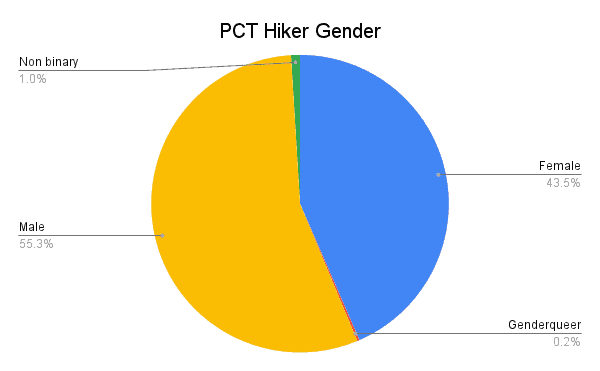
PCT Hiker Age
- 0.72% < 20
- 9.95% 20-24
- 26.50% 25-29
- 19.42% 30-34
- 11.51% 35-39
- 10.31 40-49
- 12.47% 50-59
- 7.67% 60-69
- 1.44% >70
Average age: 37
Median age: 33
σ: 13
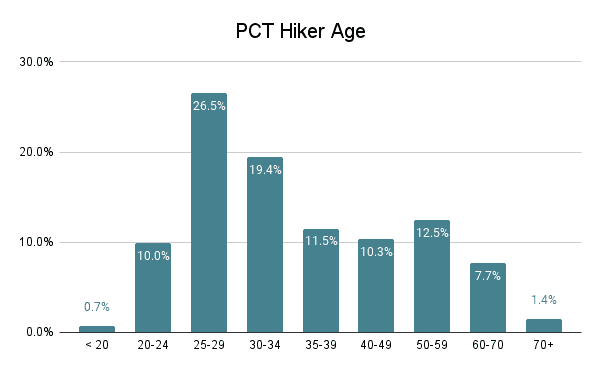
PCT Hiker Race
- 90.7% White
- 3.7% Two or More Races
- 2.8% Asian
- 0.2% Hispanic or Latino
- 0.2% Middle Eastern
- 0.2% Black or African American
- 0.2% American Indian or Alaska Native
- 1.7% Decline to answer
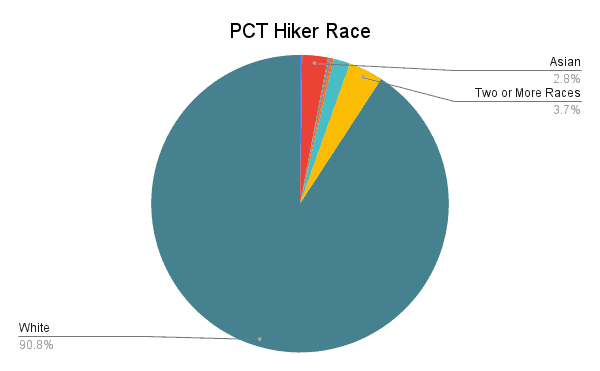
PCT Hiker Education
- 47.5% Bachelor’s degree
- 22.7% Master’s degree
- 8.7% Some college (no degree)
- 5.3% Associate degree
- 4.5% High school or equivalent
- 4% PhD
- 2.7% MBA
- 2.2% MD
- 0.8% JD
- 0.5% Trade school
- 0.4% Postgraduate degree
- 0.2% 12th grade or less
- 0.1% DDS
- 0.5% Decline to answer
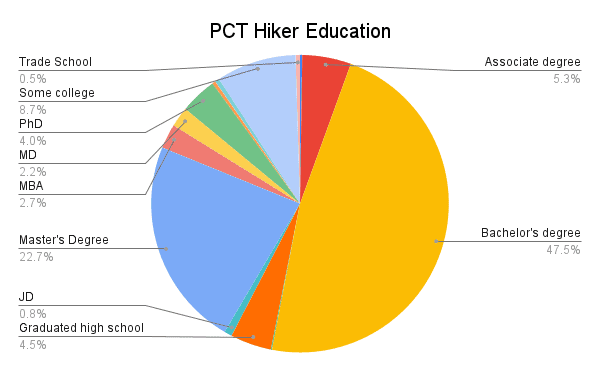
PCT Hiker Sexual Orientation
- 78.4% Heterosexual (straight)
- 8.2% Bisexual
- 2.8% Gay
- 2.4% Queer
- 2.1% Asexual
- 1.6% Lesbian
- 0.8% Pansexual
- 3.7% Decline to answer

PCT Hiker Marital Status
- 45.1% Single, never married
- 25.6% Married or domestic partnership
- 21.7% In a committed relationship
- 4.7% Divorced
- 1.4% In an open relationship
- 1.3% Separated
- 0.1% Widowed
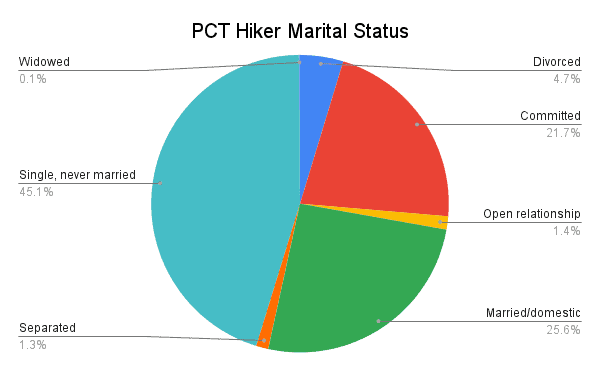
PCT Hiker Children
- 80.7% No children
- 3.6% One child
- 8.3% Two children
- 5.7% Three children
- 1.2% Four children
- 0.5% Five children
- 0.1% Eight children
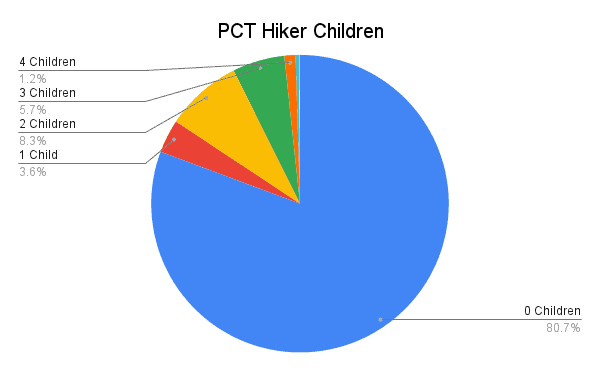
Where Hikers Are From
With its growing popularity, the Pacific Crest Trail attracts people from across the United States and the world. Here’s a look at where hikers on the trail this year hailed from.
- Australia, Austria, Belgium, Canada, Czech Republic, Denmark, England, Estonia, Finland, France, Germany, Greece, India, Ireland, Israel, Italy, Latvia, Lithuania, Mexico, Netherlands, New Zealand, Norway, Russia, Scotland, Slovakia, South Africa, Sri Lanka, Sweden, Switzerland, Taiwan, Thailand, Ukraine, United States (33 total)
Worldwide PCT Hiker Distribution

European PCT Hiker Distribution
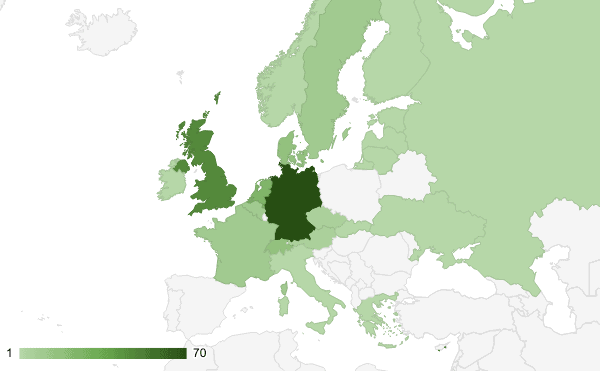
USA PCT Hiker Distribution
Alabama, Alaska, Arizona, Arkansas, California, Colorado, Connecticut, Delaware, Florida, Georgia, Hawaii, Idaho, Illinois, Indiana, Iowa, Kentucky, Louisiana, Maine, Maryland, Massachusetts, Michigan, Minnesota, Mississippi, Missouri, Montana, Nevada, New Hampshire, New Jersey, New Mexico, New York, North Carolina, Ohio, Oklahoma, Oregon, Pennsylvania, South Carolina, South Dakota, Tennessee, Texas, Utah, Vermont, Virginia, Washington, Washington DC, West Virginia, Wisconsin, Wyoming (47 total)
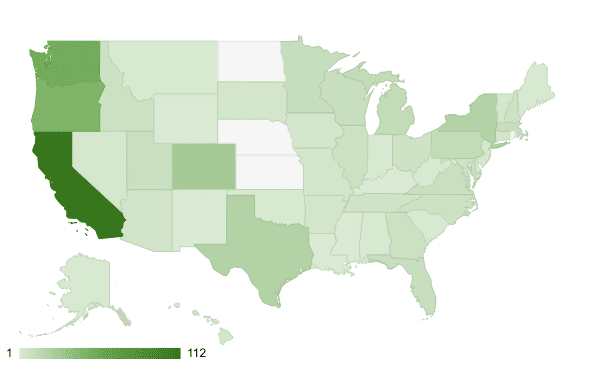
The Most-Represented Countries
- USA – 60.3%
- Germany – 8.6%
- Canada – 6.6%
- United Kingdom – 5.1%
- Netherlands – 3.2%
The Most-Represented States
- California – 23.2%
- Oregon – 10.8%
- Washington – 9.5%
- Colorado – 5.6%
- New York & Texas – 4.1% (each)
Hiker Jobs & Working Conditions
How are you able to take off enough time to hike across the United States? Probably a question most would-be Pacific Crest Trail hikers have been asked. I ask hikers what they do for work (when they’re not being incredible hiking machines) and how they are able to take time off to hike the PCT.
PCT Hiker Jobs
This year, hikers reported 198 different professions. The most common of which were:
- 6.8% Educator/Teacher
- 4.3% Software Engineer
- 3.6% IT
- 3.5% Scientist
- 3.1% Engineer
- 2.7% Project Manager
- 2.6% Mechanical Engineer
10.3% (larger than any single profession) reported being retired and 4.5% were students. More on this in the next section.
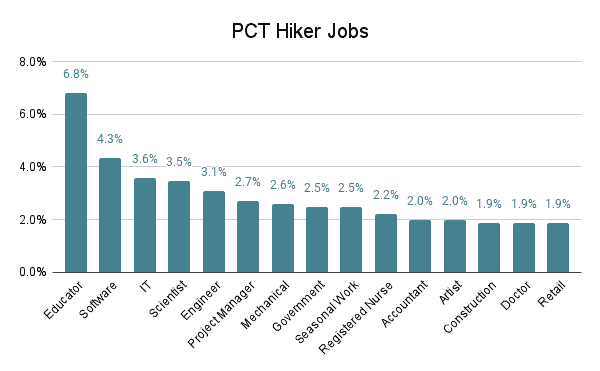
PCT Hiker Working Conditions
How were this year’s thru-hikers able to take the time to hike the PCT?
- 36.8% Quit job
- 11.7% Unpaid time off
- 10.5% Flexible working conditions
- 9.4% Sabbatical
- 9.1% Retired
- 7.9% Between jobs
- 3.8% Student
- 3.6% Gap year
- 3.5% Unemployed
- 2.2% Seasonal worker
- 1.3% Negotiated into employment
- 0.3% Military leave

Hiker Experience & Training
Here’s a look at what the 2022 class looked like during their “Planning a PCT Hike” phase. This section examines time spent planning, first-time hikers, hiker experience level, and other trails hiked.
Time Spent Planning
I ask thru-hikers how much time they spend planning for their thru-hikers on a scale of 0 (no time at all) to 10 (every waking moment). I will drill down in a future post on whether this had any impact on hikes.
- 0 – 1.9%
- 1 – 3.0%
- 2 – 8.2%
- 3 – 15.8%
- 4 – 11.1%
- 5 – 16.0%
- 6 – 11.5%
- 7 – 12.4%
- 8 – 12.4%
- 9 – 3.2%
- 10 – 4.6%
Average: 5.2
Median: 5
σ: 2.4
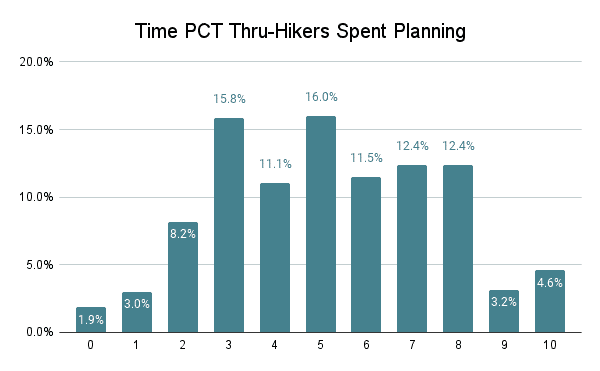
PCT Hiker Experience Level
Instead of asking thru-hikers whether this would be/was their first long-distance hike, I ask the distance of thru-hikers‘ longest hike to date (pre-PCT) – more on the specifics of this below. I use 100 mi / 160 km as the cutoff for being considered to have completed a long-distance hike (sorry, Wonderland Trail hikers). If you want to yell at me for the arbitrary number I chose here (or suggest a better one), feel free to do so in the comments at the end of this post.
First Time Thru-Hikers
- 43.1% Yes
- 56.9% No
Average longest trail hiked: 458 mi / 737 km
Median: 110 mi / 177 km

PCT Hiker Experience
In addition to asking about the longest trail completed by thru-hikers pre-PCT, I ask thru-hikers to evaluate their backpacking experience on a scale of 1 to 10.
- Average experience: 5.9
- Median experience: 6
- σ: 2.8
Thru-Hikers (1): 5.9 | σ = 2.7
Thru-Hikers (0): 6 | σ = 2.8
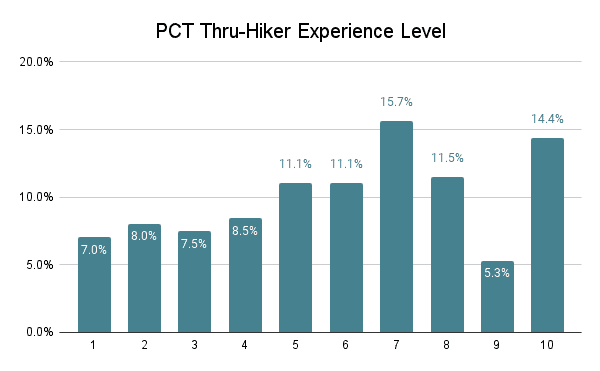
Previous Trails Hiked
The trails most commonly hiked by those with experience were:
- 9.9% Appalachian Trail
- 6.9% PCT Section Hike
- 6.6% John Muir Trail
- 5.0% AT Section Hike
- 4.9% Colorado Trail
- 4.5% Camino de Santiago
- 3.9% Kungsleden
- 2.8% Long Trail
- 2.7% Tahoe Rim Trail
- 2.3% GR20
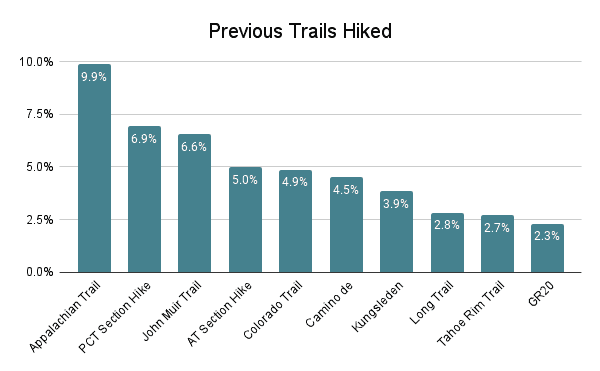
Note: these percentages are of the hikers who have already completed a long-distance hike, not of the entire class.
Pre-Hike Training
Next, we’ll look at whether thru-hikers trained in preparation for their thru-hikes, what they did (if anything) to train, and how thru-hikers rated their fitness (pre-PCT).
Did Hikers Train
- 72.8% Yes
- 27.2% No

How Hikers Trained
- 50.5% Day Hikes
- 31.1% Running
- 26.9% Multi-day Hikes
- 25.5% Weight Training
- 14% Bicycling
- 9.1% Cross-Training
- 7.1% Step Machine
- 3.3% Swimming
- 6.9% Other
“Other” mostly consisted of mobility exercises, walking, and yoga.

Pre-Trail Fitness Level
I asked thru-hikers to rate their level of fitness (on a scale of 0 to 10) before beginning the trail.
Average fitness: 5.8
Median fitness: 6
σ: 1.7
Thru-Hikers (1): 5.9 | σ = 1.7
Thru-Hikers (0): 5.7 | σ = 1.8

NOBO vs. SOBO Terminus Travel
The question of whether to hike the Pacific Crest Trail northbound or southbound is perhaps one of the first questions hikers have to answer once they commit to a thru-hike.
This year, I will be posting a more detailed breakdown of northbound versus southbound PCT thru-hikers. For now, we’ll look at why hikers chose to southbound (northbound is the more popular option for thru-hikers). I also asked hikers this year, for the first time, about their travel to and from the southern and northern terminuses at the starts and ends of their hikes.
Northbound Thru-Hikers
Getting to the Southern Terminus
Here’s how northbound thru-hikers got to the southern terminus of the PCT to begin their hikes.
- 29.5% – Friend/Family Member
- 27.3% – Trail Angel from San Diego
- 17.8% – Bus to Campo from San Diego
- 11.9% – PCT Southern Terminus Shuttle
- 7.9% – Rideshare/Taxi
- 2.4% – Transportation with another hiker
- 2.4% – Trail angel from elsewhere
- 0.6% – Hitchhiking
- 0.3% – Bus to Campo from elsewhere

Leaving the Northern Terminus
When northbound PCT hikers reach the northern terminus at the US/Canada border they (typically) have the option of crossing into Canada and hiking to Manning Park (done via obtaining prior authorization) or turning around and hiking back to Harts Pass in Washington. This is because there is no vehicle access at the northern terminus.
However, this is the first year I asked hikers this question and it turns out this wasn’t (or was?) the best year to start due to wildfire closing the northernmost section of the PCT to the border.
Here’s how hikers responded to the question, “Did you cross the US/Canada Border and hike into Manning Park?”
- 62.1% – No, hiked back to Harts Pass
- 21.1% – Ended early due to fires
- 9.5% – Hiked alternate route to the border
- 4.7% – Yes
- 2.6% – Hiked from Manning Park south to the monument
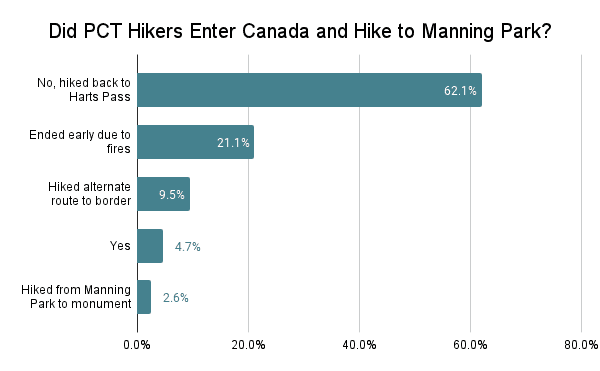
Southbound Thru-Hikers
Southbound PCT hikers begin their hikes with a logistical challenge. To officially begin at the northern terminus, they first need to reach Harts Pass in Washington (the closest road access in the US to the border). Then they need to hike northbound nearly 31 mi 50 km to reach the northern terminus at the US-Canada Border.
Getting to Harts Pass
Here’s how southbound thru-hikers got to the northern terminus of the PCT to begin their hikes.
- 42.9% – Friend/Family Member
- 39.3% – Trail Angel
- 14.3% – Hitchhiking
- 3.6% – Shuttle
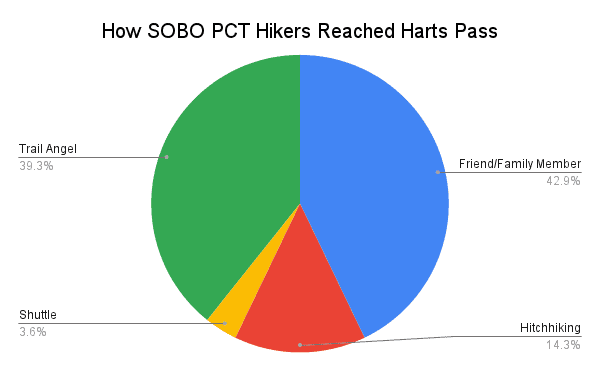
Getting to the Northern Terminus
Here’s how southbound thru-hikers got to the northern terminus of the PCT to begin their hikes.
- 77.8% – Hiked to the terminus
- 22.2% – Began hike elsewhere
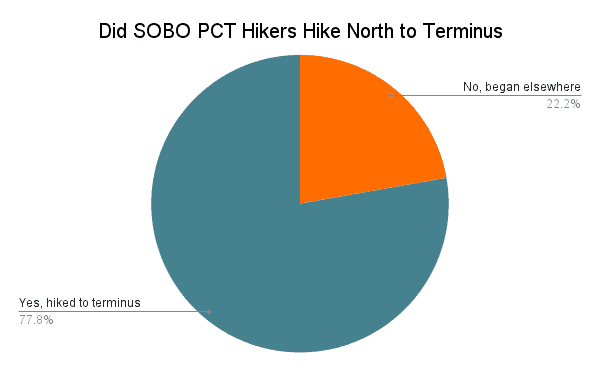
Leaving the Southern Terminus
Here’s how southbound thru-hikers got back from the southern terminus of the PCT at the end of their hikes.
- 57.1% – Friend/Family Member
- 25.0% – Bus from Campo
- 10.7% – Private transport with another hiker
- 7.1% – Trail Angel
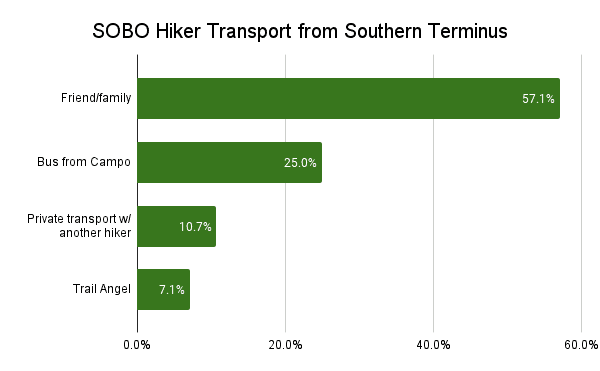
Why Hikers Went Southbound
Here are the motivations behind southbound thru-hiker decisions to begin their hikes at the US-Canada Border.
- 64.9% – Better timeframe
- 54.1% – To avoid crowds
- 46.0% – For a unique experience
- 32.4% – Less permit competition
- 5.4% – Already hiked NOBO
- 5.4% – Logistically easier
- 5.4% – Recommended by a former hiker

Money Spent on Hike
How much does it cost to hike the Pacific Crest Trail? This a question on the minds of many thru-hikers before starting their hikes. The safe answer? More than you think. I wrote an article on PCT costs, but the aggregate data from this year’s class will paint a more accurate picture.
Thru-Hikers (1)
$9,593
The average amount spent on the entirety of a thru-hike
M = $9,000 | σ = $5,329
Thru-Hikers (1)
$69
The average amount spent per day on a thru-hike
M = $60 | σ = $49
Thru-Hikers
$1,510
The average amount spent on gear before starting
M = $1,025 | σ = $1,248
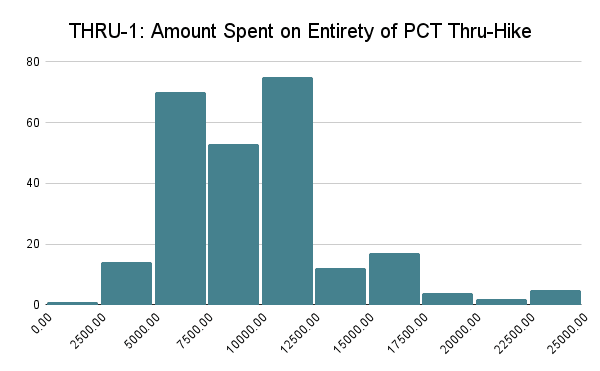
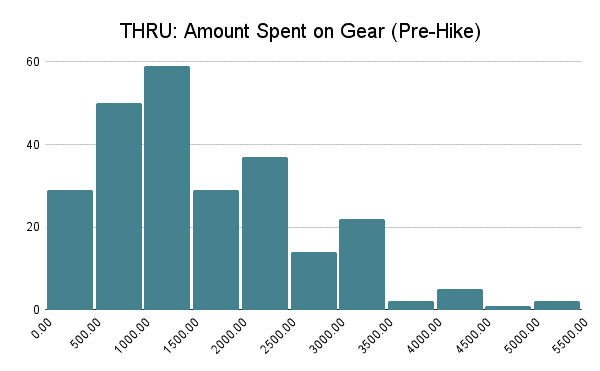
Thru-Hikers (1)
$7,981
Average spent by domestic thru-hikers
M = $7,000 | σ = $3,688
Thru-Hikers (1)
$9,857
Average spent by international thru-hikers
M = $9000 | σ = $5,567
I ask Pacific Crest Trail hikers if they encountered any unexpected expenses while hiking the PCT. Even if you purchase and test all your gear beforehand and pre-package all of your resupplies (I strongly recommend against this resupply strategy), you can’t predict what’s going to happen during a PCT thru-hike. As part of this breakdown, I also ask thru-hikers how much they spend on gear during their thru-hikes – this could be either repairing, replacing, or supplementing gear.
Surprise Expenses Encountered
- 54% Yes
- 46% No
Unexpected expenses fell into three categories: gear replacement, hotel stays, and travel along the trail. However, a few hikers did report some towns being unexpectedly pricey and medical expenses in addition to these three larger reasons.

Surprise Expense Breakdown
44.9% Hotel Stays
- 12.9% due to fires
- 12.7% due to injury
- 11.3% due to illness
- 8% due to weather
41.4% Gear Related
- 27.5% replacing failing gear
- 12.3% replacing hated gear
- 1.5% replacing lost/stolen gear
29.2% Travel Along the Trail
- 21.3% due to fires
- 3.7% due to injury
- 2.7% due to illness
- 1.3% due to weather
2.6% Towns More Expensive than Expected
- 1.4% Food
- 1.2% Hotels
1.3% Medical Expenses
0.8% Other
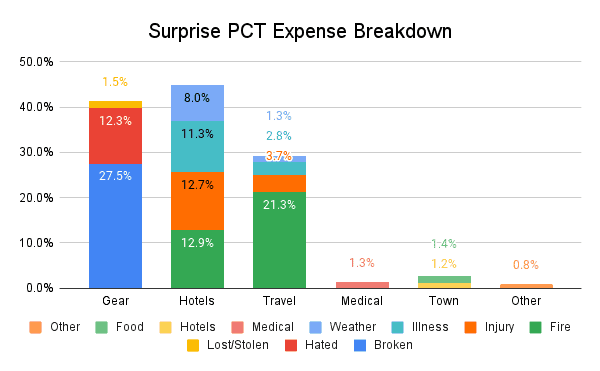
Hiking Partners, Camping, & Alone Time
Beginning a thru-hike on your own can sound scary and intimidating, but every year, the majority of thru-hikers (and hikers in general) began their hikes alone. Here, we’ll look at who hikers began with, how much time they spent hiking and camping alone (and cowboy camping), whether they stayed with their hiking partner(s), hiking group sizes, and hiker relationships.
Did hikers begin alone?
- 70.2% Yes
- 15.7% Began with a partner or spouse
- 8.2% Began with a friend(s)
- 4.1% Began with a family member(s)
- 1.6% Arranged to start with other hikers (whom they had not met before beginning the PCT)
- 0.3% Began with a client
Of this year’s first-time thru-hikers, 73.5% began their hikes alone.

Time Hiking Alone
- 5.7% – 0%
- 8.3% – 1-10%
- 4.4% – 11-20%
- 4.2% – 21-30%
- 3.7% – 31-40%
- 6.3% – 41-50%
- 5.5% – 51-60%
- 10.2% – 61-70%
- 15.6% – 71-80%
- 19.6% – 81-90%
- 15.3% – 91-99%
- 3.7% – 100%
71.9% – Average time thru-hikers who began alone spent hiking alone
σ = 25.3 | M = 80%
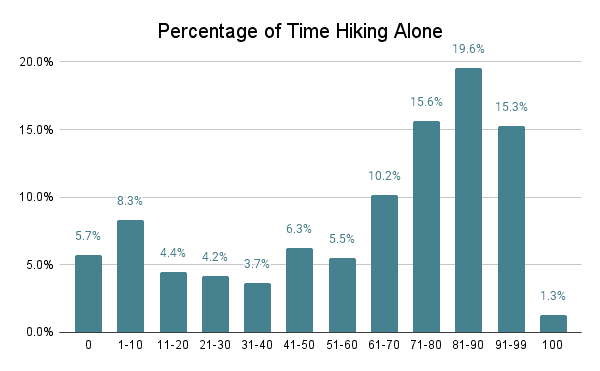
“Hiking alone” measures the amount of time that hikers weren’t physically walking with someone down the trail. It does not necessarily imply they weren’t hiking with others throughout the day (i.e. camping with others).
Nights Camped Alone
- 20.1% – 0%
- 38.3% – 1-10%
- 10.4% – 11-20%
- 6.0% – 21-30%
- 4.3% – 31-40%
- 5.8% – 41-50%
- 2.5% – 51-60%
- 3.1% – 61-70%
- 4.2% – 71-80%
- 3.8% – 81-90%
- 1.3% – 91-99%
- 0.3% – 100%
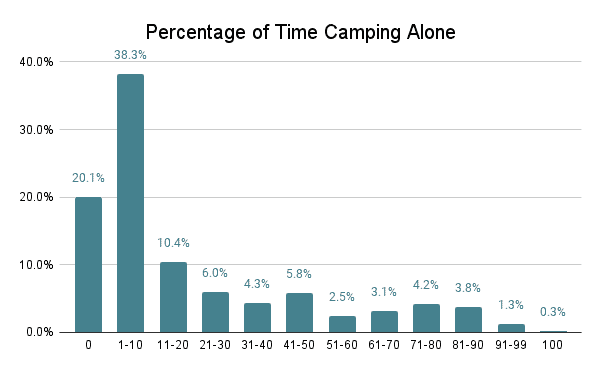
22% was the average percentage of nights thru-hikers, spent camping alone (M = 8 | σ = 28). When we look at thru-hikers who finished, this translates to an average of 27 nights spent camping alone.
Nights Cowboy Camping
- 19.3% – 0%
- 43.2% – 1-10%
- 11.4% – 11-20%
- 6.0% – 21-30%
- 4.8% – 31-40%
- 3.4% – 41-50%
- 1.8% – 51-60%
- 2.7% – 61-70%
- 2.3% – 71-80%
- 2.3% – 81-90%
- 2.5% – 91-99%
- 0.3% – 100%
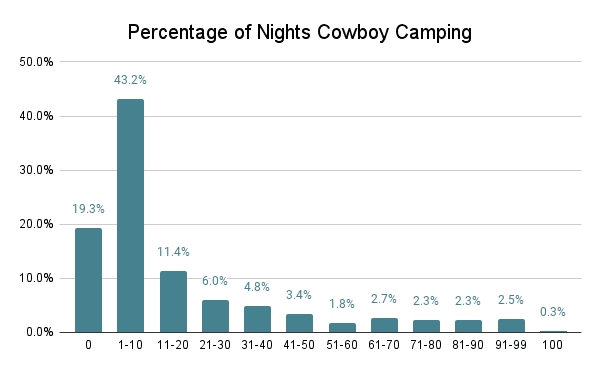
18% was the average percentage of nights thru-hikers, spent cowboy camping (σ = 26 | M = 5). When we look at thru-hikers who finished, this translates to an average of 25 nights spent cowboy camping.
Sticking With Hiking Partner(s)
Beginning a hike with someone is one thing, but managing to remain together and finishing a hike with someone is arguably as impressive as the trail itself. Here’s how things worked out for those who began their hikes with another person.
Remaining with Partner(s)
- 61.7% Yes
- 12.2% No, never the plan
- 10.8% Yes, for the most part
- 8.1% No, partner got off
- 5.4% No, we decided it wasn’t for the best
- 0.9% No, we’re no longer friends
- 0.9% No, broken up
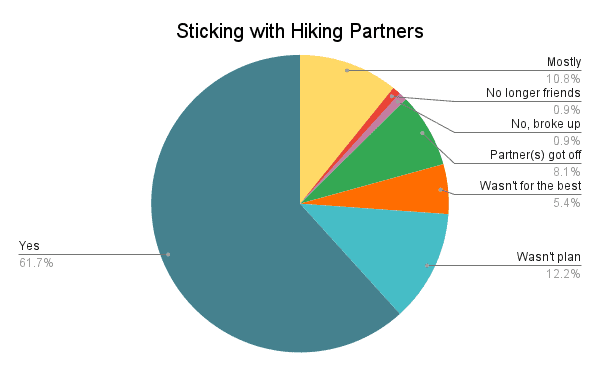
Size of Hiking Groups
Despite the majority of hikers beginning their Pacific Crest Trail hikes alone, most hikers will link up and hike with at least one other person for a considerable amount of their time on the PCT. Some hikers refer to this as a trail family or “tramily“. Here are the largest groups hikers found themselves hiking with on a regular basis.
Average group size: 5.8
Median size: 5
σ: 4
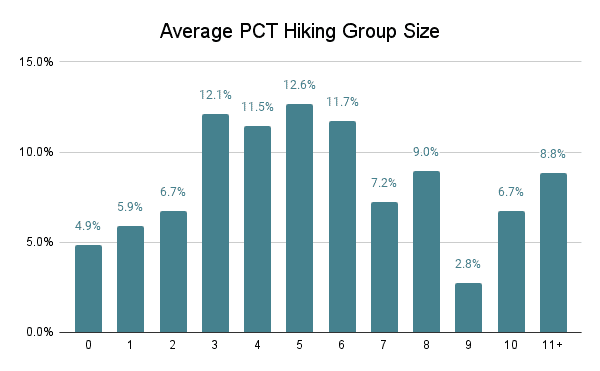
Relationship Status
Here, I ask thru-hikers, “at the start of the PCT, were you in a relationship?”
- 46.4% Yes, and I am still with the same person
- 42.5% No, and I am still single
- 6.5% No, but now I am in a relationship with someone I met on the PCT
- 2.8% Yes, but I am now single
- 0.9% Yes, but now I am in (a different) relationship with someone I met on the PCT
- 0.8% No, but now I am in a relationship with someone I met before the PCT
- 0.1% Yes, but now I am in (a different) relationship with someone I met before the PCT
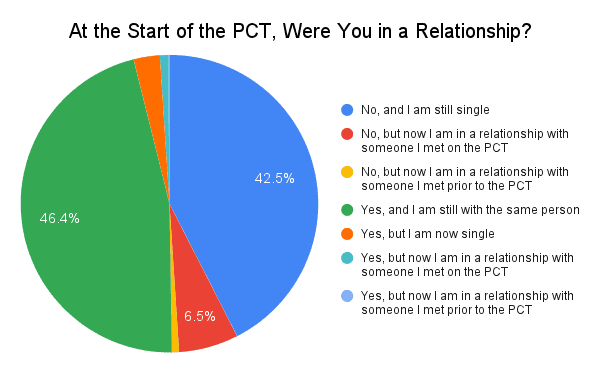
Overall, the PCT ended 3.9% of hiker relationships, but it gave new relationships to 7.3% of hikers; a net gain of 3.4%.
Permits & Starting Dates
The rules and procedures for obtaining and possessing a Pacific Crest Trail permit are constantly evolving. This year, as expected, northbound permit slots for March, April, and May all filled up quickly and completely. If everything operated exactly as official permits dictate, there were 50 hikers beginning northbound hikes every day from the southern terminus in Campo.
98.6% of thru-hikers reported having obtained a permit from the PCTA. Is this a good thing? Yes. If you’re hiking the PCT should you get a permit? Absolutely.
Here we look at whether hikers got permits for the start dates they wanted, whether they began their hikes on their permit start dates, and what the average start dates were for finishers and those who wish they had started earlier or later.
Did hikers receive a permit for the day they wanted?
Permits for the PCT are (generally) issued in two phases and require you to preregister and be online at a designated time as hikers are randomly allowed to request permit start dates. I asked this year’s class whether they got a permit for the date they wanted and whether they were happy with their permit’s date.
- 57.2% Permit for date wanted
- 60.7% Permit +/- 1 day of date wanted
- 64.1% Permit +/- 3 days of date wanted
- 68.1% Permit +/- 5 days of date wanted
- 78.3% Permit +/- 10 days of date wanted
- 21.7% Permit > 10 days of date wanted
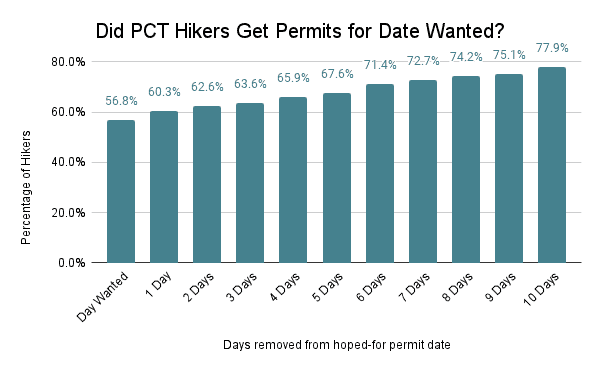
Begin on Permit Date
- 76.8% Yes
- 23.2% No
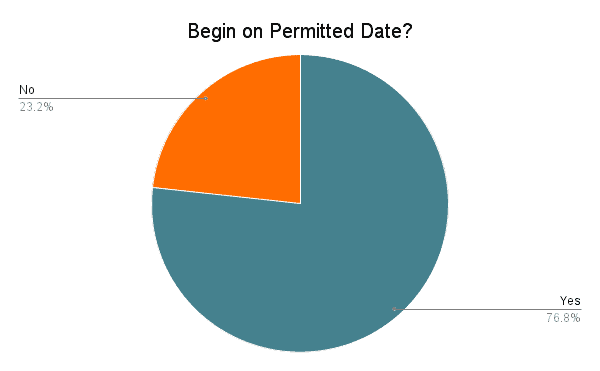
Hiker Start Dates
Northbound
April 7
Average start date of thru-hikers happy with their start date
Northbound
March 25
Average start date of thru-hikers who said they would like to have started later
Northbound
April 25
Average start date of thru-hikers who said they would like to have started earlier
Southbound
July 9
Average start date of thru-hikers happy with their start date
Southbound
July 7
Average start date of thru-hikers who said they would like to have started later
Southbound
July 10
Average start date of thru-hikers who said they would like to have started earlier
Hiking Stats & Dates
The Pacific Crest Trail is generally considered to have five sections: the Desert, the Sierra, Northern California, Oregon, and Washington.
Kennedy Meadows (south) is the Desert/Sierra division (despite the Sierra range technically beginning further south), and Echo Lake/South Lake Tahoe is commonly considered the Sierra/Northern California division (yes, the Sierra technically continues north). Basically “the Sierra” section of the PCT can also be considered “the section of the PCT that is most commonly filled with snow for the largest number of hikers (i.e. northbound hikers)”. That said, the “Sierra” section of the survey (for the purposes of the question) measures the distance from Kennedy Meadows to Echo Lake (just north of Echo Summit on Highway 50 where hikers typically access South Lake Tahoe).
In this section, we look at how long thru-hikers took for each section of the trail, a breakdown of hike lengths and averages, and a look at how many days hikers took off (zero/nearo days).
Northbound Hike Breakdown
- 44 (NOBO-1) – Average days hiking the Desert
- 30 (NOBO-1) – Average days hiking the Sierra
- 34 (NOBO-1) – Average days hiking Northern California
- 19 (NOBO-1) – Average days hiking Oregon
- 30 (NOBO-1) – Average days hiking Washington
- 148 (NOBO-1) – Average days to complete the PCT
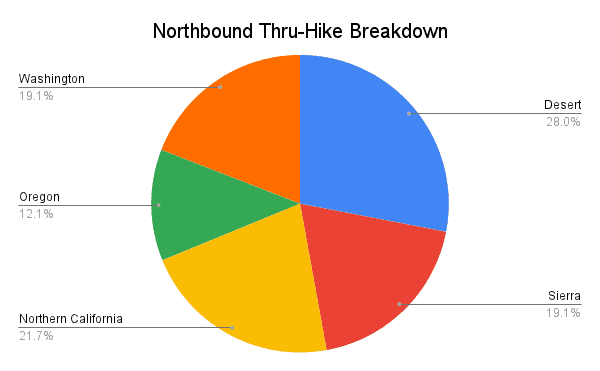
Southbound Hike Breakdown
- 44 (SOBO-1) – Average days hiking Washington
- 23 (SOBO-1) – Average days hiking Oregon
- 29 (SOBO-1) – Average days hiking Northern California
- 22 (SOBO-1) – Average days hiking the Sierra
- 37 (SOBO-1) – Average days hiking the Desert
- 135 (SOBO-1) – Average days to complete the PCT
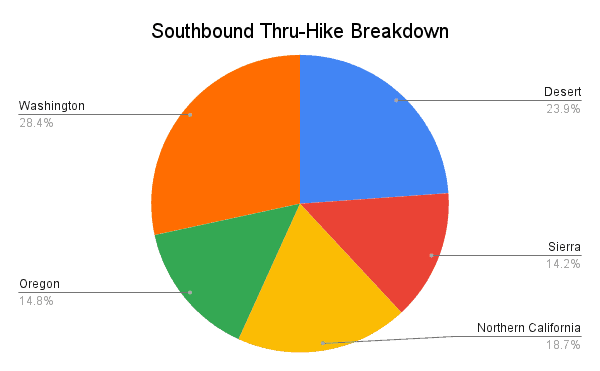
If you’re paying attention above you may notice that simply adding up the average time for each section does not equal the average time for the entire trail. This is because I have taken all these averages independently of one another and I do not have complete data for the dates (and therefore section lengths) for all hikers who completed the survey.
Length of Thru-hikes
Thru-Hikers (1)
148
The average number of days of an entire thru-hike
(M = 149 | σ = 22)
Thru-Hikers (1)
132
The average number of days hiking (total minus zero days)
(M = 132 | σ = 18)
Northbound (1)
9/12
The average finish date (12/9 for the rest of the world)
(M = 9/8 | σ = 25)
Thru-Hikers (1)
18.3 mi
The average daily mileage (29.5 km)
(σ = 3 mi / 4.8 km)
Thru-Hikers (1)
20.6 mi
The average daily mileage after removing zero days (33.2 km)
(σ = 3.2 mi / 5.2 km)
Thru-Hikers (1)
37.2 mi
The average longest day of hiking (59.9 km)
(M = 34 | σ = 9.3 mi / 15 km)
Zero and Nearo Days (i.e. Days Off)
Thru-Hikers (1)
17
The average number of zero days (days off from hiking)
(M = 15 | σ = 9)
Thru-Hikers (1)
16
The average number of nearo days (low mileage days)
(M = 15 | σ = 8)
Thru-Hikers (1)
5
The average longest consecutive number of zero days
(M = 4 | σ = 3.8)
Flip-Flopping, Completion Rates, & Footpaths
Flip-flopping is when a hiker skips a section of the trail (the flip) intending to come back to hike it later (the flop). This can happen because a hiker wants to avoid snow, skip a fire closure, or because of some other logistical issue. The flip-flop usually takes one of two forms.
One is a hiker skipping ahead, continuing to hike in the same direction, and then returning to the point they originally departed the trail to hike the skipped section later (e.g. a northbound hiker skips from the CA/OR border to the OR/WA border, then hikes north to Canada before returning to the CA/OR border to hike north to the OR/WA border).
It can also be when a hiker skips ahead and then hikes the skipped section in the opposite direction of their original hike before jumping back up to the point where they originally skipped to and continuing their hike in the original direction (e.g. northbound hiker jumps from CA/OR border to OR/WA border and then hikes south to CA/OR border before returning to OR/WA border to continue hiking north).
Some hikers get wild with their flip-flopping (I recommend avoiding it if possible) and there are rules in place that invalidate PCT permits for the Sierra if hikers fail to hike this section continuously (hikers can still flip-flop and get local permits to legally hike the Sierra).
Here is what flip-flopping on the PCT looked like in 2022.
Did Hikers Flip-Flop
Thru-Hikers 22% Yes
Thru-Hikers 78% No
Northbound 21% Yes
Northbound 79% No
Southbound 36% Yes
Southbound 64% No
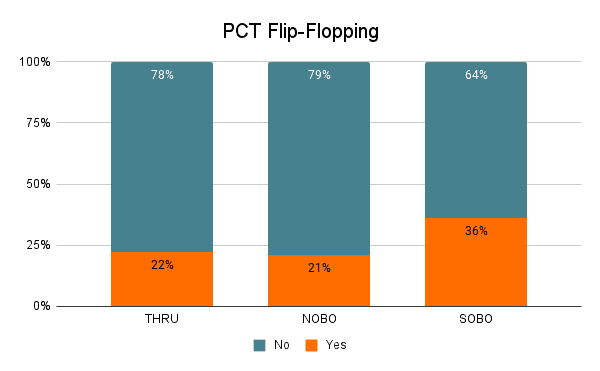
Why Hikers Flip-Flopped
- 82.6% Fires
- 8.4% Snow
- 3.6% Personal/Logistical
- 3.0% Injury
- 1.8% To meet/stay with a friend/hiking partner
- 0.8% Heat

Where Hikers Flipped From/To
I’ve struggled in the past to display this information in a way I think will be helpful and accurately represent the PCT flip-flopping picture, but I think this is an improvement upon previous years. I’ve taken a few liberties here, removing any one-off flip-flops reported (i.e. the plane(s) mentioned don’t appear elsewhere) and combining places that are next to one another (e.g. Timberline Lodge and Government Camp) as a means of making the data a bit more readable. Please let me know if you have any suggestions. I am considering a more detailed flip-flopping post based on the data.
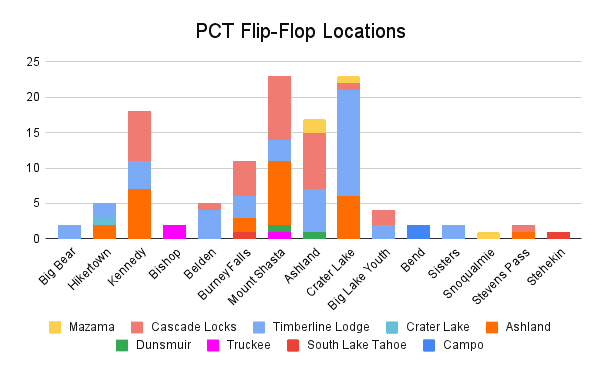
PCT Completion Rates
Most people begin a Pacific Crest Trail thru-hike intending to complete the trail. Unfortunately (or in some cases, fortunately), not everyone who sets out on this most epic adventure of border-to-border glory completes the trail. Every year a large percentage of people hoping to hike the PCT will fail to complete the trail.
We’re going to look at completion rates, but we are doing so with a caveat. Since I distribute this survey myself, and because it is not required of PCT hikers, survey respondents are a self-selecting group who (likely) skew toward having completed the trail. A hiker who quit during their first week of hiking back in March or April is probably paying little attention and caring far less about the Pacific Crest Trail survey when it’s released in the fall.
Thru-Hikers
65%
The percentage of thru-hikers who completed the PCT.
Northbound
64%
The percentage of northbound thru-hikers who completed the PCT.
Southbound
78%
The percentage of southbound thru-hikers who completed the PCT.
It may sound straightforward enough, “Did you complete the PCT? Yes or no?” but what constitutes a completed thru-hike isn’t necessarily the same for everyone.
Some people insist you need to have unbroken steps between Mexico and Canada along the official Pacific Crest Trail to constitute a thru-hike while others may forgive skipping a road walk, hitchhiking around a fire closure, or taking an alternate (or shortcut).
To get a better idea of how much of the trail this year’s finishers hiked, I asked about their footsteps between the terminuses.
Continuous Footpaths
For this question, I ask hikers, “Did you hike a continuous and unbroken footpath between borders?”
- 18.6% Yes
- 41.4% Yes, but I skipped the fire closures
- 16.1% Mostly, but I may have missed a few miles
- 14.4% No, I skipped or hitched past small sections of the trail
- 9.4% No, I skipped or hitched past large sections of the trail
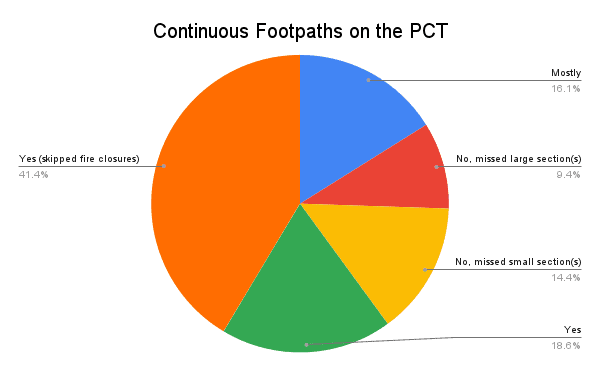
Alternate Routes
The Pacific Crest Trail is well-defined, but there are several alternate trails (sometimes, but not always, known as “shortcuts”) hikers can take either instead of or in addition to the official PCT. I ask about these alternates to get an idea of what the most common PCT thru-hikes looked like. Alternates are listed in geographical order from south to north.
The following colors indicate the popularity of each alternate (the percentage of hikers who took each): over 75%, 50-75%, 25-50%, and below 25%.
Desert Alternates
- Spitler Trail – 2.3%
- South Ridge Trail – 1.4%
- Devil’s Slide Trail – 45%
- Deer Springs Trail – 7.3%
- Marion Mountain Trail – 0.5%
- Black Mountain Road – 0.9%
- Cougar Crest Trail – 0.9%
- Acorn Trail- 13.1%
- Buckhorn Camp Detour – 6.1%
- Upper Shake Campground – 1.5%
Sierra Alternates
- Trail Pass Trail – 6.8%
- Cottonwood Pass Trail – 18%
- Army Pass Trail – 0.4%
- New Army Pass Trail – 0.6%
- Whitney Portal Trail – 23.5%
- Kearsarge Pass Trail – 80.4%
- Sawmill Pass Trail – 0.3%
- Bishop Pass Trail – 6.6%
- Piute Pass Trail – 0.1%
- Blayney Meadows Trail – 0.3%
- Bear Ridge Trail – 21.8%
- Goodale Pass Trail – 10.6%
- Cascade/Fish Valley Trail – 0.3%
- Duck Pass Trail – 2.2%
- Mammoth Pass Trail – 33.9%
- Devils Postpile Trail – 33.8%
- John Muir Trail (between Red’s Meadow and Thousand Island Lake) – 10.8%
- Tuolumne Campground Trail – 8.2%
- John Muir Trail to Yosemite Valley – 1.3%
Northern California Alternates
- Bucks Lake Alternate – 8.8%
- Castella Trail – 5.2%
Oregon Alternates
- Callahan’s Side Trail – 14.3%
- Hyatt Lake Resort – 11.2%
- Mazama Campground (Crater Lake) – 60%
- Crater Lake Rim Alternate – 84.1%
- Whitefish Horse Camp Trail – 6.2%
- Shelter Cove Trail – 37.8%
- Elk Lake Resort Trail – 26.7%
- Big Lake Youth Camp Trail – 50%
- Paradise Park Trail – 4.8%
- Ramona Falls Alternate – 51.8%
- Eagle Creek Trail – 68.9%
Washington Alternates
- Stevenson Roadwalk – 1.8%
- Old PCT Route past Old Snowy Mountain – 38.7%
- Goldmyer Hot Springs Alternate – 0.5%
- Holman Fire Detour – 0.3%
- Miner’s Ridge Trail – 0.7%
- Robinson Creek Trail – 0.7%
- Billy Goat Trail – 0.8%
Not an alternate, but instead a side trip (typically done as an out-and-back from the PCT), hikers on the Pacific Crest Trail pass just west of Mount Whitney in the Southern Sierra. The highest peak in the Continental United States at 14,505 ft / 4,421 m, it’s a tempting investment of time that most hikers take advantage of (the trip up from the PCT is easier, shorter, and less crowded than the trip up from the Whitney Portal Trailhead on the eastern side).
NOTE: A PCT permit allows you to day hike Mount Whitney from the western side (i.e. the PCT). You are not permitted to exit the Sierra via Whitney Portal or camp east of the Crabtree Ranger Station (this includes Guitar Lake).
Summit Mount Whitney
Did thru-hikers summit Mount Whitney when hiking through the Sierra?
- 75.7% Yes
- 24.3% No
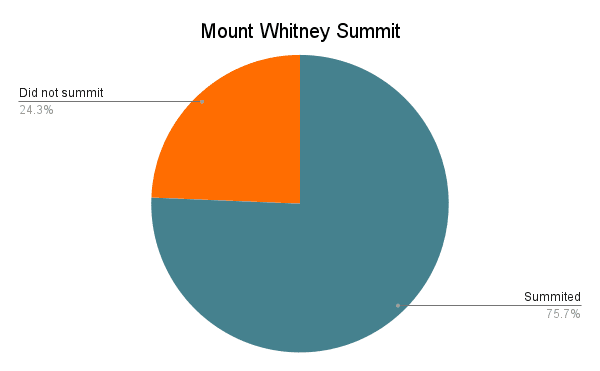
Why Hikers Didn’t Summit
I asked the 24.3% of thru-hikers who didn’t summit Mount Whitney what stopped them from doing so. Not that you have to, but I thought it curious to know hikers’ motivations for missing the peak.
- 24.6% Didn’t make it that far
- 22.5% No interest in summiting
- 18.7% Already summited (another time)
- 13.9% Problems with altitude
- 13.4% Weather
- 5.9% Behind schedule
- 5.9% Skipped section
- 4.8% Not enough food
- 4.3% Partner didn’t want to
- 4.3% Snow concerns
- 3.2% Illness
- 3.2% Personal/logistical
- 1.6% Injury
- 0.5% To stay with friends
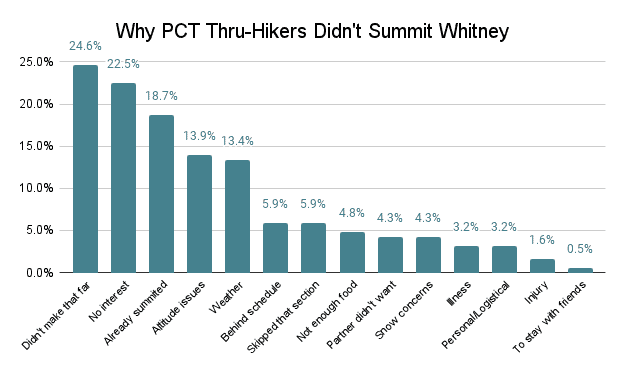
Hiker Challenges
The Pacific Crest Trail can be a challenging place for hikers. Here, we’ll cover which sections of the trail hikers found most difficult and which sections were considered, by hikers, to be the easiest.
I also ask hikers about their experience in the Sierra (and if you’re paying close enough attention to be reading this, I remind you that it should always be “Sierra” or “Sierra Nevada” and not “Sierras” or “Sierra Nevadas” or “Sierra Nevada Mountains”). We’ll see which Sierra passes hikers found most challenging, which hikers found to be easiest, and how well hikers coped with a variety of factors including storms, fires, mosquitoes, and stream crossings.
Easiest PCT Section
- 20.7% – The Desert
- 2.8% – The Sierra
- 9.5% – Northern California
- 64.4% – Oregon
- 2.6% – Washington
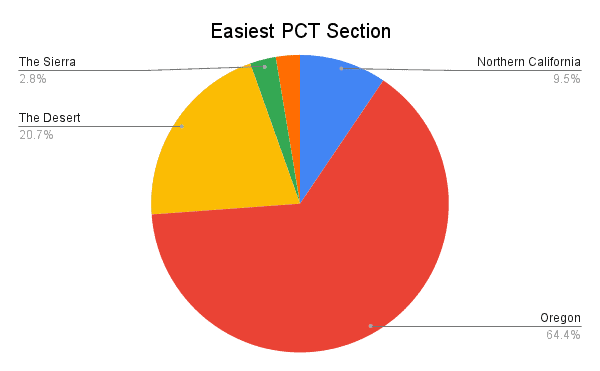
Most Difficult PCT Section
- 9.8% – The Desert
- 44% – The Sierra
- 14.7% – Northern California
- 3.8% – Oregon
- 27.7% – Washington

Easiest Sierra Passes
Below are the passes in the Sierra Nevada listed from south to north along with the percentage of hikers who ranked that pass as the easiest.
- 13.9% – Mulkey Pass
- 13.4% – Trail Pass
- 17.9% – Cottonwood Pass
- 19.6% – Forester Pass
- 20.1% – Kearsarge Pass
- 14.2% – Glen Pass
- 11% – Pinchot Pass
- 10.4% – Mather Pass
- 8.2% – Muir Pass
- 32.1% – Selden Pass
- 31.3% – Silver Pass
- 42.1% – Island Pass
- 29.4% – Donohue Pass
- 23.4% – Benson Pass
- 45.7% – Dorothy Lake Pass
- 0.3% – Sonora Pass

Most Challenging Sierra Passes
Below are the passes in the Sierra Nevada listed from south to north along with the percentage of hikers who ranked that pass as the most challenging.
- 0.1% – Mulkey Pass
- 0.1% – Trail Pass
- 0.7% – Cottonwood Pass
- 19.4% – Forester Pass
- 11.3% – Kearsarge Pass
- 25.2% – Glen Pass
- 24.9% – Pinchot Pass
- 43% – Mather Pass
- 50.2% – Muir Pass
- 4% – Selden Pass
- 5.6% – Silver Pass
- 0.1% – Island Pass
- 5.2% – Donohue Pass
- 3.3% – Benson Pass
- 1.5% – Dorothy Lake Pass
- 1.8% – Sonora Pass

On-Trail Issues
I asked hikers, on a scale of 1 to 10, how much of an issue each of the following was during their hikes. Here are the averages from thru-hikers who finished.
- 5.68 – Mosquitoes
- 5.39 – Smoke/Fire
- 4.82 – Heat
- 3.27 – Wind
- 2.86 – Cold
- 2.44 – Snow
- 2.36 – Elevation
- 2.21 – Stream Crossings
- 1.58 – Storms/Lightning
- 1.31 – Rain/Hail
- 1.17 – Rodents
- 1.15 – COVID
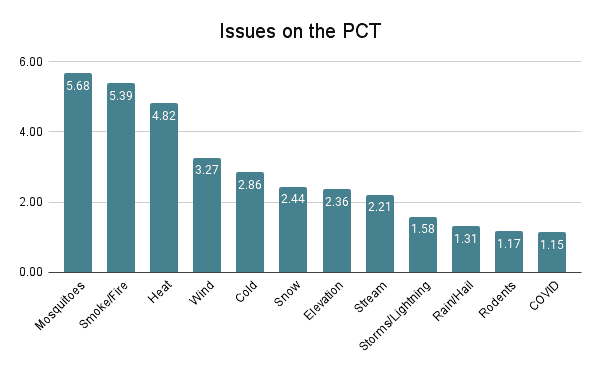
Why Hikers Didn’t Finish
In case you were left wondering what happened to the hikers who didn’t complete the PCT this year when we covered the completion rates above, fear not. Here are the specifics as to why hikers didn’t complete the Pacific Crest Trail.
This section looks at the reasons thru-hikers got off the trail, how those who got off with injuries were injured, where hikers were injured, and how many miles were completed by thru-hikers who ended their hikes early.
Why Hikers Stopped Hiking
- 44.6% – Fires
- 19.7% – Injury
- 7.8% – Family
- 7.8% – Illness
- 7.1% – Personal
- 4.5% – Boredom
- 2.6% – Work
- 1.5% – Financial
- 1.5% – Other
- 1.1% – Snow
- 1.1% – Visa
- 0.4% – Medical
- 0.4% – School
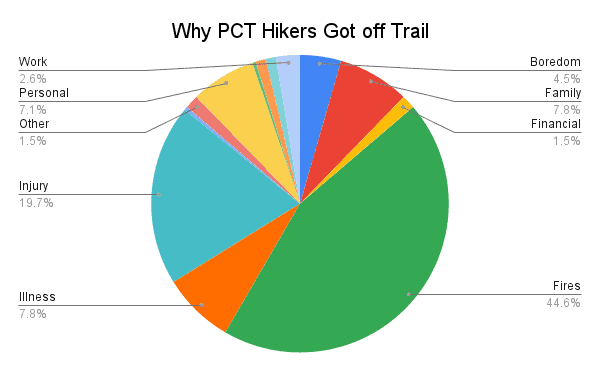
Hike-Ending Injury Breakdown
Injury is a big killer of thru-hikes and is typically something hikers can exercise some control over (as opposed to fires that can flare up seemingly without warning on the PCT). Here, we break down what kinds of injuries ended hikes and where these hike-ending injuries occurred.
Hike-Ending Injuries
- 17.4% – Overuse injury (foot)
- 17.4% – Overuse injury (leg)
- 13% – Broken bone (foot)
- 8.7% – Stress fracture (leg)
- 8.7% – Torn Tendon
- 6.5% – Stress fracture (foot)
- 6.5% – Back Injury
- 6.5% – Hip Injury
- 4.3% – Knee Injury
- 2.2% – Plantar fasciitis
- 2.2% – Concussion
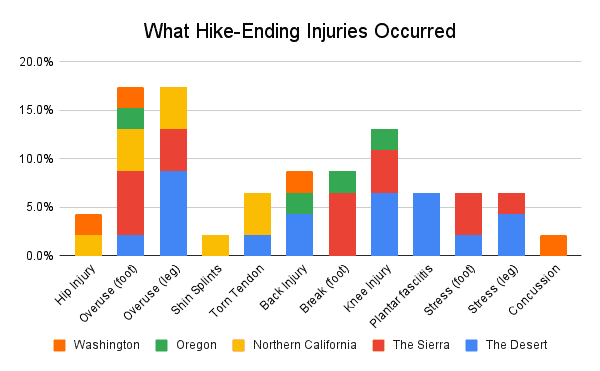
Where Injuries Occurred
- 37% – The Desert
- 28.3% – The Sierra
- 17.4% – Northern California
- 8.7% – Oregon
- 8.7% – Washington
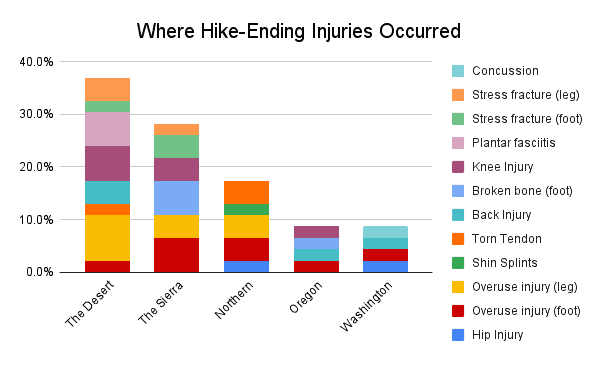
Miles Completed by Hikers
This information reflects the number of miles completed by hikers who did not complete the entire Pacific Crest Trail.
- 1.2% – < 100 mi (< 160 km)
- 2.7% – 100-250 mi (160 – 402 km)
- 6.6% – 250-500 mi (402 – 805 km)
- 7.8% – 500-750 mi (805 – 1207 km)
- 9.7% – 750-1000 mi (1207 – 1609 km)
- 10.1% – 1000-1250 mi (1609 – 2011 km)
- 7.8% – 1250-1500 mi (2011 – 2414 km)
- 8.6% – 1500-1750 mi (2414 – 2816 km)
- 11.3% – 1750-2000 mi (2816 – 3218 km)
- 13.2% – 2000-2250 mi (3218 – 3620 km)
- 21% – > 2250 mi (> 3620 km)
Average: 1,586 mi / 2,552 km
Median: 1,700 mi / 2,736 km
σ = 740 mi / 1,191 km
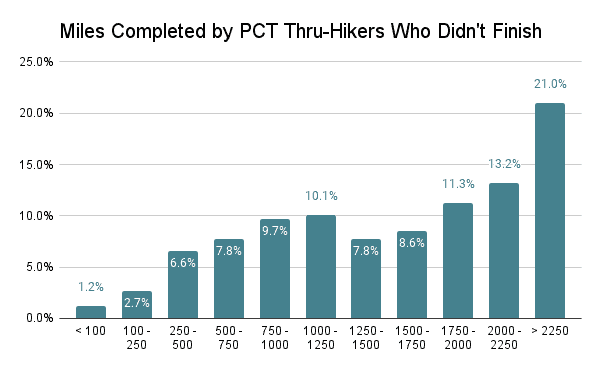
Resupply
The word “resupply” can be anxiety-inducing if you’re new to the idea of long-distance thru-hiking. What is resupply? Where does it come from? How much of it is there? How do you get it? Will it hurt?
Resupply is getting yourself more food to power more hiking. It need not be scary or intimidating. Pacific Crest Trail resupply has become more simple over the years, but when and where hikers resupply is still a question that many find overwhelming.
Here we have this year’s resupply stats, resupply strategy/boxes, resupply box suggestions, hitchhiking difficulties, where hikers resupplied, favorite and least favorite resupply stops, favorite meals and snacks, and resupply advice.
PCT Resupply Stats
Thru-Hikers (1)
31.4
The average number of resupplies over the entire trail
(M = 32 | σ = 5.3)
Thru-Hikers (1)
4.7
The average number of days between resupplies
(M = 4.7 | σ = 1.2)
Thru-Hikers (1)
87.3
The average number of miles between resupplies (140.5 km)
(M = 83 mi / 133 km | σ = 16 mi / 26 km)
Thru-Hikers
3.5
The average number of resupply boxes prepared ahead of time
(M = 1 | σ = 8.5)
Thru-Hikers (1)
7.5
The average total number of resupply boxes sent
(M = 6 | σ = 5.1)
Thru-Hikers (1)
22%
The average percent of resupplies sent as boxes
(M = 15% | σ = 23%)
Resupply Strategy
- 1.9% Mailed all resupply
- 7.4% Mailed most resupply (> 50%)
- 44% Mailed some resupply (10-50%)
- 37.2% Mailed a few resupply (1-10%)
- 9.5% Mailed no resupply

Many prospective PCT thru-hikers find themselves incredibly concerned about resupply – but take a breath. Remember you can mail yourself boxes from on the trail. You do not have to have all your resupply boxes (or resupply locations) prepared ahead of time. Many towns have supermarkets (and post offices).
That said, it can be helpful (and time-saving) to mail yourself resupply boxes. Hikers may choose this option because of a resupply stop’s limited food selection, dietary restrictions, high prices, or even the owners of the local resupply establishment being awful people (that said, most are lovely).
Something else to consider when thinking about resupply is the fact that many towns along the PCT are only accessible via car (or ludicrously long, dangerous, and ill-advised road walks). How do you get to these towns? Many hikers elect to hitchhike.
Here are the places hikers say they recommend sending a resupply box and where they had difficulty hitchhiking to/from.
Suggest Mailing Resupply
- Stehekin (Washington) 71%
- Kennedy Meadows (South)* (Sierra) 37%
- White Pass (Washington) 35%
- Snoqualmie Pass (Washington) 33%
- Stevens Pass/Skykomish (Washington) 29%
- Crater Lake National Park (Oregon) 28%
- Acton KOA (Desert) 27%
- Sierra City (Northern California) 25%
- Shelter Cove Resort (Oregon) 22%
- Warner Springs (Desert) 16%
*Kennedy Meadows (South) is where most hikers begin carrying bear canisters. The most popular bear canister from this year? (And every year.) The BV500. I’m a fan of the BV450, but more on that in the gear guide.
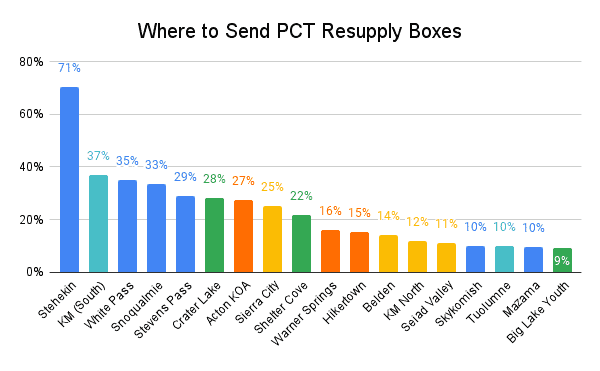
Difficult Hitches
- Bishop (Sierra) 8.4%
- Leavenworth (Washington) 8.2%
- Etna (Northern California) 7%
- South Lake Tahoe (Sierra) 6.8%
- Quincy (Northern California) 4.6%
- Chester (Northern California) 4%
- Independence (Sierra) 4%
- Bend (Oregon) 3.8%
- Mazama (Washington) 3.6%
- Truckee (Northern California) 3.6%
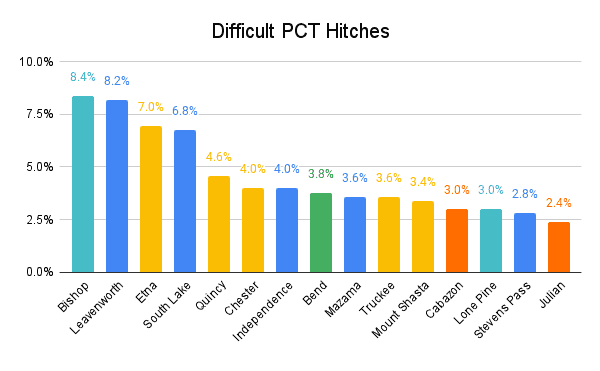
Where Hikers Resupplied
I ask hikers to report on where they resupplied – not where they stopped/passed through, but where they actually purchased, picked up, were given, or otherwise came into a new stock of food. For example, the trail passes through the middle of Agua Dulce; theoretically, all thru-hikers who complete the trail will go there, but not all thru-hikers resupply there. Make sense? I hope so. If you’re struggling with this, you’ll have issues on the trail.
Locations are listed in geographical order from Mexico to Canada (that’s south to north) and, again, I use the following colors to indicate each resupply stop’s popularity: over 75%, 50-75%, 25-50%, and below 25%.
Desert Resupply
- Campo – 10.8%
- Lake Morena – 20.9%
- Mount Laguna – 50.6%
- Julian – 73.7%
- Montezuma Valley Market – 34.6%
- Warner Springs* – 43.5%
- Paradise Cafe – 14.8%
- Idyllwild – 89.6%
- Anza – 1.6%
- Cabazon – 23.7%
- Banning – 7.7%
- Palm Springs – 8.2%
- Cajon Pass – 29.1%
- Big Bear City – 36.4%
- Big Bear Lake – 59%
- Wrightwood – 84.8%
- Acton KOA* – 45.8%
- Acton – 26.8%
- Agua Dulce – 19.5%
- Palmdale – 4.5%
- Lancaster – 2.2%
- Hikertown – 50.8%
- Wee Vill Market – 14.7%
- Tehachapi – 89.8%
- Mojave – 4.5%
- Onyx – 1.2%
- Lake Isabella – 10%
- Kernville – 8.8%
- Ridgecrest – 40.1%
Sierra Resupply
- Kennedy Meadows* – 58.7%^
- Grumpy Bears Retreat – 23%^
- Triple Crown Outfitters – 61.9%^
- Lone Pine via Horseshoe Meadow – 22.4%
- Independence via Horseshoe Meadow – 1%
- Bishop via Horseshoe Meadow – 7.1%
- Lone Pine via Kearsarge Pass/Onion Valley – 11.7%
- Independence via Kearsarge Pass/Onion Valley – 7.8%
- Bishop via Kearsarge Pass/Onion Valley – 65.6%
- Muir Trail Ranch – 3.4%
- Bishop via Bishop Pass/South Lake – 5.5%
- Bishop via Piute Pass/North Lake – 0.4%
- Vermilion Valley Resort – 36.5%
- Red’s Meadow – 10.9%
- Mammoth Lakes – 86.6%
- Tuolumne Meadows – 43.7%
- Yosemite Valley – 15.8%
- Lee Vining – 5.9%
- Bridgeport – 3.7%
- Kennedy Meadows North – 83.7%
- Strawberry – 0.3%
- Markleeville – 4.1%
^All these locations are located in Kennedy Meadows (South) – at the same point in the PCT
Northern California Resupply
- Echo Lake – 6.8%
- South Lake Tahoe – 91.1%
- Stateline – 0.6%
- Sacramento – 1.9%
- Tahoe City – 3%
- Soda Springs – 1.9%
- Truckee – 41.3%
- Reno – 2.3%
- Sierra City* – 78.5%
- Quincy – 46.8%
- Chico – 1.9%
- Chester – 63.8%
- Bucks Lake – 1.7%
- Caribou Crossroads – 9.2%
- Belden – 34.9%
- Old Station – 38.5%
- Burney Falls – 12.5%
- Burney – 71.9%
- Castella – 9.1%
- Dunsmuir – 24.3%
- Mount Shasta – 62.8%
- Etna – 72.8%
- Seiad Valley – 60.2%
Oregon Resupply
- Callahan’s – 10.1%
- Ashland – 75.2%
- Hyatt Lake Resort – 1.4%
- Medford – 16.3%
- Fish Lake – 13.7%
- Lake of the Woods Resort – 2.4%
- Crater Lake (Mazama Village)* – 80.2%
- Diamond Lake Resort – 3%
- Chemult – 1.6%
- Shelter Cove Resort* – 57.7%
- Odell Lake Resort – 2.4%
- Elk Lake Resort – 13.1%
- Eugene – 0.8%
- Sisters – 23%
- Bend – 61.3%
- Big Lake Youth Camp – 18.8%
- Olallie Lake Resort – 19.4%
- Government Camp – 9.7%
- Timberline Lodge – 27.4%
- Cascade Locks – 71.8%
- Hood River – 16.9%
- Portland – 20.2%
WASHINGTON RESUPPLY
- Trout Lake – 80.5%
- White Pass* – 81.7%
- Packwood – 14.4%
- Snoqualmie Pass* – 92.1%
- Stevens Pass* – 49%
- Skykomish* – 28.1%
- Seattle – 6.8%
- Monroe – 0.2%
- Wenatchee – 2.2%
- Leavenworth – 49.1%
- Chelan – 0.5%
- Stehekin* – 82.2%
- Winthrop – 5.5%
- Mazama – 19%
*stops where this year’s class suggests sending resupply boxes to
Favorite & Least Favorite Resupply Stops
Now we know the most popular stops for resupplying and for sending resupply boxes, but what about hikers’ favorite and least favorite resupply stops? When asking this question I specify “‘Favorite/Least Favorite’ means where you most/least enjoyed, not where had the best/worst resupply options (although these could be the same).”
Favorite Resupply Stop
Idyllwild, CA
Desert (56.8%)
Least Favorite Resupply Stop
Acton KOA, CA
Desert (20.7%)
Favorite Resupply Stops
- Desert: Idyllwild (56.8%)
- Sierra: Bishop (45.2%)
- Northern California: Etna (27.3%)
- Oregon: Ashland (37.1%)
- Washington: Stehekin (30.1%)
Runners-Up
- Desert: Wrightwood (37.7%)
- Sierra: Mammoth Lakes (40.8%)
- Northern California: South Lake Tahoe (26.9%)
- Oregon: Bend (31.3%)
- Washington: Trout Lake (27.5%)
Least Favorite Resupply Stops
- Desert: Acton KOA (20.8%)
- Sierra: Kennedy Meadows (15.3%)
- Northern California: Belden (19.9%)
- Oregon: Crater Lake National Park (7%)
- Washington: White Pass (10.8%)
Runners-Up
- Desert: Hikertown (18.9%)
- Sierra: Grumpy Bears Retreat (10%)
- Northern California: Seiad Valley (14.7%)
- Oregon: Shelter Cove Resort (7%)
- Washington: Stehekin (7%)
Dietary Restrictions, Meals, and Snacks
For the final piece of the resupply puzzle, we take a look at hiker dietary restrictions, how easy they found resupplying with these restrictions, and which meals and backpacking snacks hikers enjoyed most out on the PCT. More on this is to come in the PCT Resupply Guide.
Dietary Restrictions
- 30.9% Yes
- 69.1% No

Specific Dietary Restrictions
- 56.3% Vegetarian
- 14.6% Vegan
- 13.5% Dairy Free
- 11.5% Pescatarian
- 8.3% Gluten Free
- 3.1% Kosher
- 2.1% Beef-free
- 2.1% Histamine intolerance
- 1% Diabetic
- 1% Keto
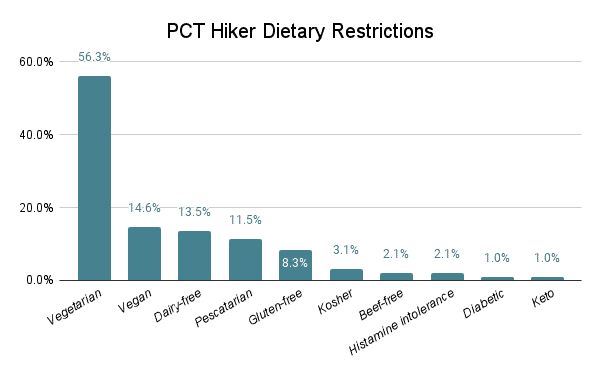
Trouble With Dietary Restrictions
I asked hikers with dietary restrictions, on a scale of 0 to 10 (0 being easy, 10 being difficult), how difficult it was to accommodate their diets while on the trail.
- 9.0 – Histamine Intolerance
- 4.9 – Gluten-Free
- 3.7 – Kosher
- 3.4 – Vegan
- 2.9 – Dairy-Free
- 2.6 – Vegetarian
- 2.5 – Beef-Free
- 1.8 – Pescatarian
- 1.0 – Keto
- 1.0 – Diabetic
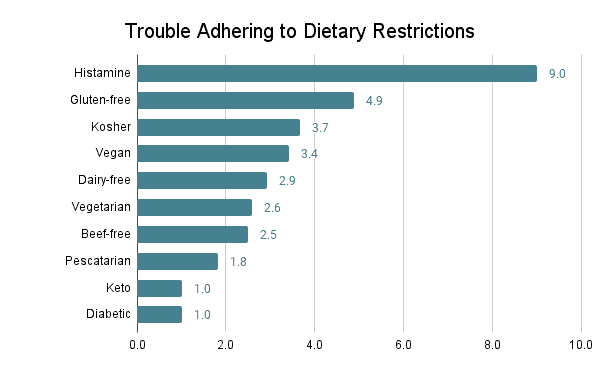
Favorite Backpacking Meals
- Peak Refuel Meals 41.4%
- Knorr Rice Sides 33.7%
- Mountain House Meals 30.7%
- Backpackers Pantry Meals 27.6%
- Good To-Go Meals 15.5%
- AlpineAire Foods 9.4%
- Greenbelly Meals 9.1%
- Food for the Sole 5.8% (out of business 😢)
- Fernweh Food Company 5.1%
- Patagonia Provisions 4.1%
Favorite Backpacking Snacks
- M&M’s 36.5%
- Lenny & Larry’s Complete Cookies 31.3%
- Snickers Bars 30.8%
- Potato Chips 26.9%
- Peanut Butter 24.9%
- Trail Mix Snacks 19.5%
- Bobos Oat Bars 19.3%
- Clif Bars 18.7%
- Pro Bars 17.9%
- Natures Bakery Fig Bars 17.4%
Resupply Changes
Hindsight is 20/20 (unless you’re looking back through the darkness for that mountain lion you think might be following you – but that’s definitely a deer). Here is what hikers said they would change about their resupply strategies if they had the chance to do it all over again. These don’t change much from year to year, so I would highly encourage you to heed this advice when considering your resupply options.
66% of hikers say that they would have made changes to their resupply strategy. Here are the most popular changes hikers would have made to their PCT resupply. Percentages are of the 66% of hikers who would have changed something – not of all hikers.
- Send fewer resupply boxes* – 27.5%
- Send more variety in boxes – 23.4%
- Send healthier food in boxes – 22.4%
- Send boxes from on trail instead of ahead of time – 19.1%
- Send more food in boxes – 16.8%
- Send less food in boxes – 14.4%
- Resupply more frequently – 13.8%
*The average number of boxes sent by hikers who said they would have liked to have sent fewer boxes was 8.7. The average was 7.5.
Thru-Hikers
8.7%
The number of thru-hikers who went stoveless for the entirety of their hikes.
I’ll be following up on this post with a more detailed breakdown of this year’s resupply. Check out the current PCT Resupply Guide (based on this data) here. Find all PCT Resupply posts here.
Thru-Hiking Gear
Potentially what Pacific Crest Trail hikers spend the most time obsessing over before (and on…and after) the trail is their thru-hiking gear. Gear choices play an essential role in a thru-hike, but there is no magical gear combination that will guarantee you a successful thru-hike (if you know otherwise, please let me know).
I do a deep dive into gear used by PCT hikers in my PCT Gear Guide, but here’s a taste of what to expect.
Thru-Hikers (1)
16.3 lbs
Average pre-hike base weight (7.39 kg)
(M = 15 lbs / 6.8 kg | σ = 5.9 lbs / 2.68 kg)
Thru-Hikers (1)
14.7 lbs
Average post-hike base weight (6.67 kg)
(M = 14 lbs / 6.35 kg | σ = 5 lbs / 2.27 kg)
Thru-Hikers (1)
-1.5 lbs
Average total change in base weight (680 g)
(M = 1 lbs / 454 g)
Thru-Hikers
54 L
Average backpack size
(M = 55)
Thru-Hikers
17.5°F
Average sleeping bag rating (-8.06°C)
(M = 20°F / -6.67°C)
Thru-Hikers (1)
4.8
Average total number of shoes used
(M = 5)
There are more detailed and more interesting breakdowns of this information on the way in this year’s PCT Gear Guide. For now, let’s take a peek at some of the gear thru-hikers were using on the trail this year. Here are the most common “Big 4” items: packs, shelters, sleeping bags, and sleeping pads (I know it’s the “Big 3”, but I include sleeping pads, get over it) along with the most common insulated jackets and shells.
Keep in mind that this is simply the most common gear used by PCT hikers – not necessarily the best (although it’s entirely possible these are the same). I will be providing breakdowns of the highest-rated gear (in addition to the most common) in the upcoming PCT Gear Guide.
Most Common PCT Backpacks
Most Common PCT Shelters
Most Common PCT Sleeping Bags/Quilts
Most Common PCT Sleeping Pads
Most Common PCT Insulated Jackets
- Enlightened Equipment Torrid (Men’s/Women’s)
- Mountain Hardwear Ghost Whisperer/2 Hoody (Men’s/Women’s)
- Patagonia Micro Puff Hoody (Men’s/Women’s)
- Decathlon Forclaz Trek 100 (Men’s/Women’s)
- Arc’teryx Cerium Hoody (Men’s/Women’s)
- Mountain Hardwear Ghost Whisperer/2 (Men’s/Women’s)
- Patagonia Nano Puff Jacket (Men’s/Women’s)
- Patagonia Micro Puff Jacket (Men’s/Women’s)
- Patagonia Nano Puff Hoody (Men’s/Women’s)
- Mountain Hardwear Ghost Whisperer UL Hoody (Men’s/Women’s)
Most Common PCT Shells
- Frogg Toggs Ultra-Lite2
- Outdoor Research Helium (Men’s/Women’s)
- Montbell Versalite (Men’s/Women’s)
- Patagonia Torrentshell 3L (Men’s/Women’s)
- Enlightened Equipment Visp (Men’s/Women’s)
- Marmot PreCip Eco (Men’s/Women’s)
- Arc’teryx Beta Jacket (Men’s/Women’s)
- Lightheart Gear Rain Jacket
- Arc’teryx Zeta FL (Men’s/Women’s)
- Black Diamond StormLine Stretch (Men’s/Women’s)
This is just the tip of the proverbial thru-hiking gear iceberg. As mentioned above, I will be publishing a detailed breakdown of this year’s PCT gear. This will include water treatment, stoves, fleeces, bear canisters, satellite messengers, fitness trackers, snow gear, hiking tops, shoes, and so-called luxury items.
This will also include a look at what hikers didn’t like about their gear, what gear decisions (might have) helped hikers to a successful thru-hike, how hikers would change/adapt their gear for a future hike, and more. I will also be publishing a women-specific gear post and a couple-specific gear post.
For more on gear, check out the Ultimate Pacific Crest Trail Packing List.
Technology on Trail
Gone are the days of the Pacific Crest Trail old when it was a trail sought out by only uber-experienced backcountry orienteers; thanks to the magic of technology, any dodo can grab a phone and have a reasonably good chance of not killing themselves on the trail.
Phones are everywhere on the trail. If the sight of a cellular device in the wilderness distresses you, then prepare yourself. Phones are hikers’ cameras, GPS devices, televisions, music players, town-researching devices, and (sometimes) SOS devices (that said, I suggest a Garmin inReach Mini 2 if you’re looking for a satellite messenger with SOS capabilities).
There are several apps commonly used by Pacific Crest Trail hikers – and even one designed specifically for the PCT (that you should most certainly invest in). Here are the apps and phones hikers were using out on the trail this year.
PCT Hiker Phones
- 60.6% iPhone
- 38.8% Android
- 0.4% Didn’t carry a phone
- 0.2% Other
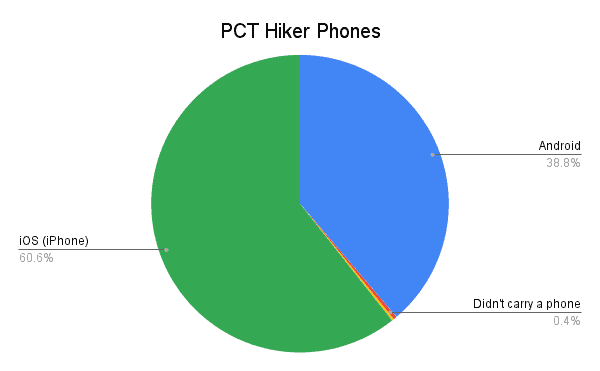
PCT Hiker Apps
- 98.0% FarOut Guides
- 33.8% Garmin Explore App
- 18.9% Gaia GPS
- 13.9% Peak Finder
- 7.7% Seek by iNaturalist
- 5.3% Strava
- 4.1% CalTopo
- 1.4% Hiker’s Logbook
- 1.3% Maps.me
- 1.1% AllTrails
- 1.0% Avenza Maps
- 0.7% Hiiker
- 0.7% Mapy.cz
- 0.6% Locus Maps
- 0.6% Merlin Bird ID
- 0.4% Backcountry Navigator
- 0.4% Komoot
- 0.2% AlpineQuest
- 0.2% Hikerbot
- 0.7% Didn’t Use Apps
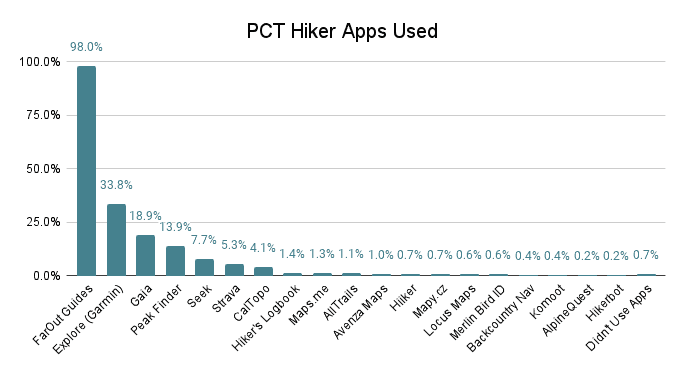
Hiker Health & Water Sources
Water treatment and personal hygiene are (or should be) big considerations for hikers. Typically thru-hikers worry less about these as the trail goes on; experience isn’t always your friend.
Some hikers religiously filter all water that passes through their face hole – it doesn’t matter if it comes out of a hotel sink or a puddle with a cow pooping in it. Other hikers will “not filter in the Sierra”, “not filter above 10,000 ft / 3,048 m”, or “not filter running water” (this last one is not a good idea – running water can 100% get you sick).
Everyone wants to look cool in front of their friends by not filtering water (note: not filtering your water does not make you cool), but there are risks to the badass thru-hiker lifestyle (and to drinking dirty, giardia-infested water).
To find out how good a job everyone is doing filtering their water and sanitizing their hands after pooping (another way to get yourself sick), I ask hikers if they got sick (defined as three or more days of digestive issues or diagnosed giardia), how often they treated water sources, and how these two things compare to one another.
PCT Hiker Illness
- 90.9% Didn’t get sick
- 9.1% Got sick

Water Treatment Frequency
- 72.6% Always
- 22.6% Usually
- 4.3% Sometimes
- 0.4% Never
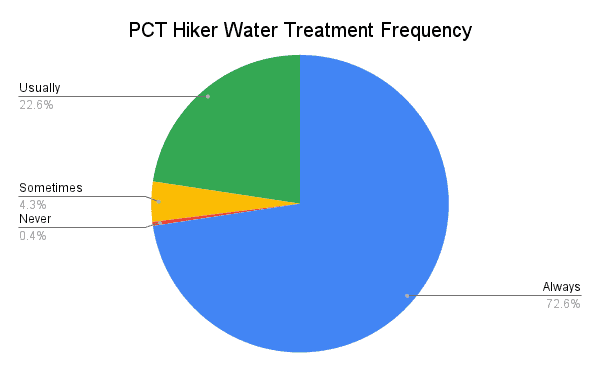
Treatment vs. Illness
- 6.2% Always treated, got sick
- 66.4% Always treated, never got sick
- 2.2% Usually treated, got sick
- 20.4% Usually treated, never got sick
- 0.8% Sometimes treated, got sick
- 3.6% Sometimes treated, never got sick
- 0% Never treated, got sick
- 0.4% Never treated, never got sick

Looking at this another way, we can see the following.
- 72.6% of hikers always treated their water and 8.5% of these hikers got sick
- 22.6% of hikers usually treated their water and 9.6% of these hikers got sick
- 4.3% of hikers sometimes treated their water and 17.5% of these hikers got sick
- 4% of hikers never treated their water and 0% of these hikers got sick
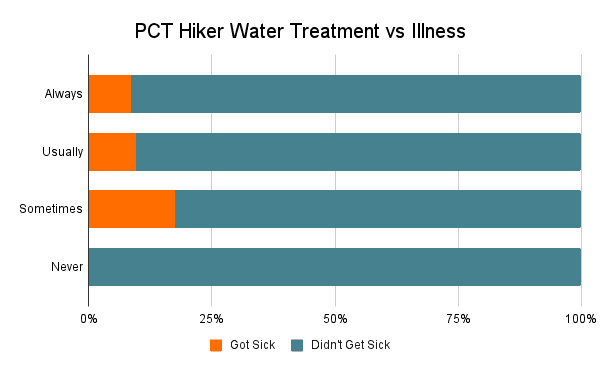
In total, a reported 9.1% of hikers came down with something akin to giardia, and 0.6% never filtered. That said, those who don’t filter are typically quite staunch in their commitment to their strategy; read: don’t readily admit to becoming sick from not filtering.
Favorite and Least Favorite Sections
This may come as a shock, but the Pacific Crest Trail is a long hike with a lot to see (mostly bears). Here is a look at the favorite and least favorite sections of the trail.
Favorite PCT Section
- Sierra
- Washington
- Desert
- Oregon
- Northern California

Least Favorite PCT Section
- Northern California
- Oregon
- Desert
- Sierra
- Washington
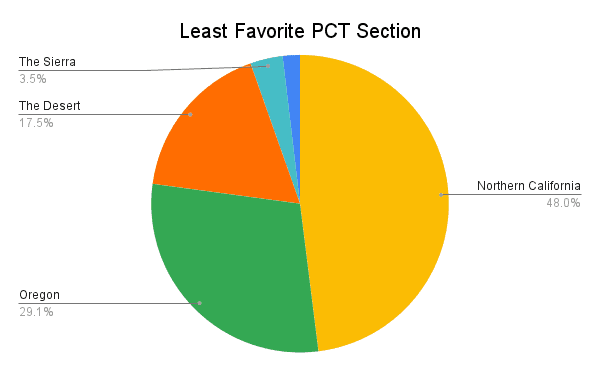
Favorite Section
Goat Rocks Wilderness
Washington (75.3%)
Least Favorite Section
Belden to Burney Falls
Northern California (43.4%)
Favorites
- Desert: Mount San Jacinto State Park (15.3%)
- Sierra: John Muir Trail (56.2%)
- Northern California: Trinity Alps Wilderness (8.2%)
- Oregon: Crater Lake (20.9%)
- Washington: Goat Rocks Wilderness (75.3%)
Runners-Up
- Desert: Mexico Border to Warner Springs (6.4%)
- Sierra: Kings Canyon National Park (40.6%)
- Northern California: Emigrant Wilderness (3.6%)
- Oregon: Three Sisters Wilderness (16.7%)
- Washington: Glacier Peak Wilderness (34.3%)
Least Favorites
- Desert: Mojave/Tehachapi to Walker Pass (38.1%)
- Sierra: Yosemite National Park (6.4%)
- Northern California: Belden to Burney Falls (43.4%)
- Oregon: Southern Oregon (36.7%)
- Washington: Southern Washington (15.3%)
Runners-Up
- Desert: The Aqueduct (32.9%)
- Sierra: John Muir Trail (0.6%)
- Northern California: Beforegon (the northernmost part of CA) (27.5%)
- Oregon: Three Sisters Wilderness (3.8%)
- Washington: Glacier Peak Wilderness (1.2%)
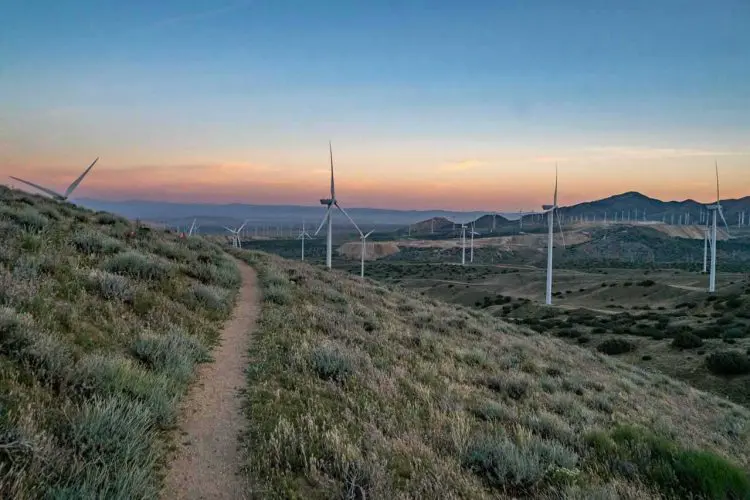
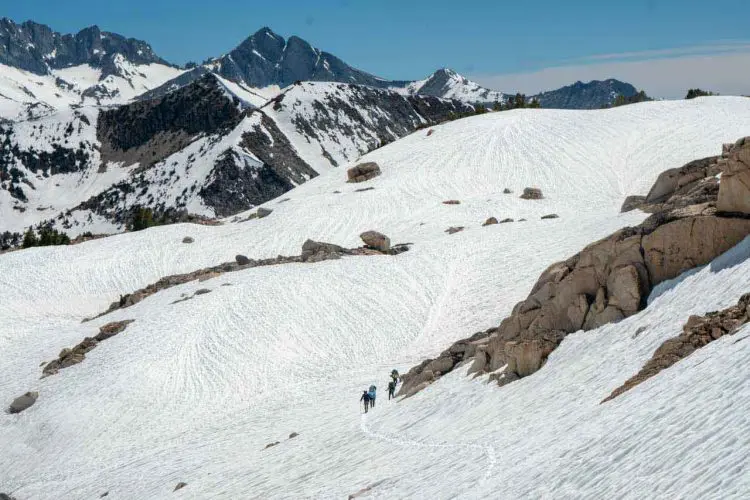
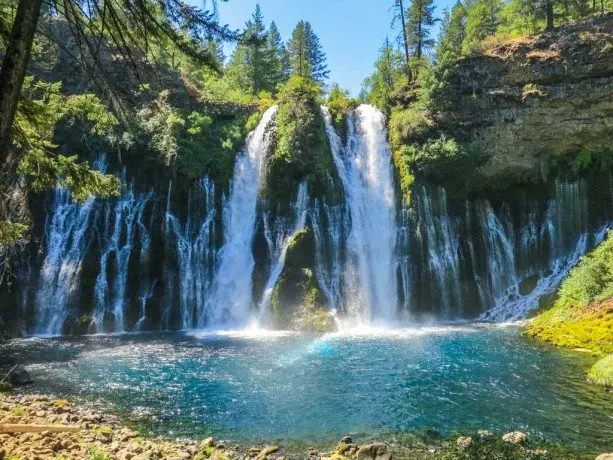
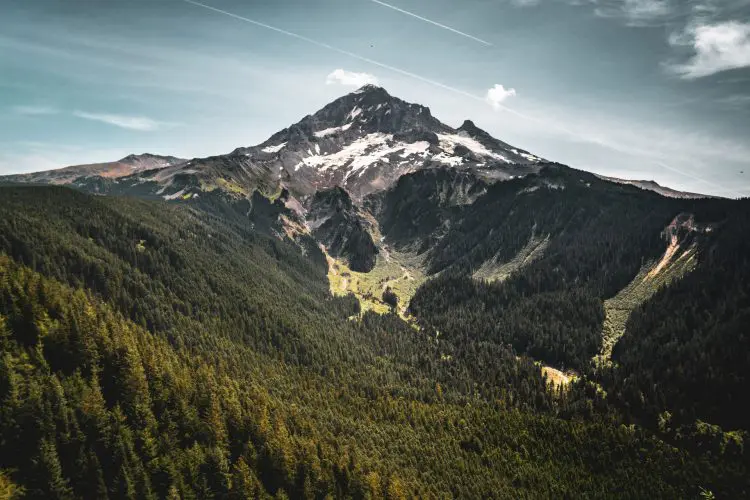
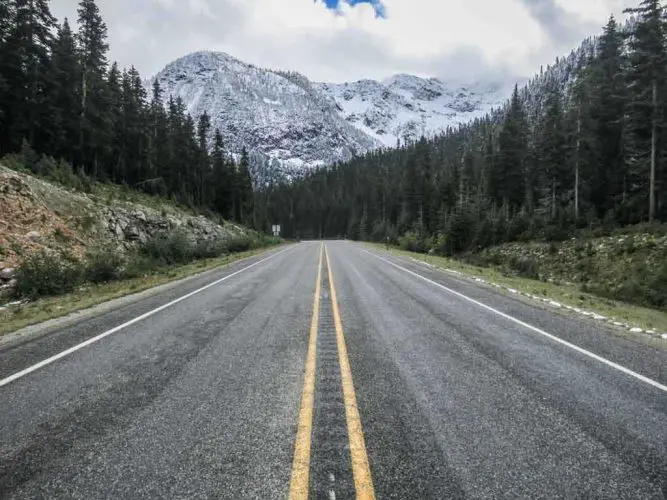
Best, Worst, Scariest, and Most Surprising Moments
I will be sharing more of these in future posts, but here are some examples that stood out when I asked hikers about their best moments, worst moments, terrifying moments, and most surprising moments from their thru-hikes.
Best PCT Moments
Last year I added a question asking hikers about their best moments from the trail and I’ve decided to keep it in this year. Below are a select few of the responses. If you are interested in reading more about hikers’ best moments on the Pacific Crest Trail, check out this post.
- One of the best days on the trail was getting to Deep Creek hot springs at dawn, soaking all morning, then heading to the Joshua Inn to have beers bought for us, songs dedicated to us, and meeting a pitbull that rode on the back of a motorcycle.
- Seiad Valley. I crushed 41 miles (66 km) that day in 112°F/44°C temperatures. Hiked 17 or so miles (27 km) around 4 mph (6.4 km/h) with one break to swim in the river. I made the grocery store just before it closed. Got beer, ice cream, pizza, pop, milk, and more pizza. Then I night-hiked out with two people on the road walk up into complete darkness. It felt so good to crush a goal, push my limits, and meet some awesome people on what was probably one of the hottest days on the trail. I really enjoyed that night hike.
- When I got over the top of Forester Pass with my trail friends, the next several miles to camp were euphoric for all of us. We felt small in that huge landscape. I’ve never felt so much like I was walking on air. We walked almost twice our normal Sierra mileage to camp, just soaking it all in and whistling tunes from Lord of the Rings.
- At the beginning of the trail near Glacier Peak, I had spent all day struggling through snow and blow-downs, feeling completely exposed and isolated. I had only seen one other person in the past few days, and near the top of Fire Creek Pass, I was worried about where I would camp. Then, I found a tiny hill sticking out of the snow with a perfectly flat spot on top. I was right above a frozen lake, surrounded by nothing but snow capped peaks, and it was the most beautiful sight I’d ever seen. I cooked Mac n Cheese while marmots ran all around me, and I just felt so lucky to be totally alone in the middle of this amazing wilderness.
Worst PCT Moments
I ask all survey respondents about their worst and/or lowest moments on the Pacific Crest Trail. Below are a select few of the responses. If you are interested in reading more about hikers’ worst moments on the Pacific Crest Trail, check out this post.
- I was dealing with Achilles tendonitis, blisters, and sore feet in Oregon heading toward the Bend area. I had to stop every hour or so to get the dust out of my shoes and socks and I was questioning whether or not to get off the trail at the next town. It was simply mentally exhausting dealing with this for a couple of weeks.
- On Muir Pass, I was about 100 feet (30 m) in front of my friends following a boot path, but it was quite hot and I was postholing a lot. The trail I was following led near the lake and I fell through the snow and water came up to my hip. I was in the lake. My initial attempts to get out of the water failed because the snow kept collapsing. Eventually, I managed to get on the snow and crawl to some rocks. I was panicking and felt awful. It took an hour before I felt comfortable hiking again.
- In Northern California, I got bitten/stung by some insect and had what seemed like an allergic reaction, even though I’ve had plenty of bee stings with no allergies in the past. I got super itchy, then sweaty, faint, and lightheaded. I had to sit down in the middle of the trail and get swarmed by gnats while I frantically scratched my entire body, from the soles of my feet to my ribs and shoulders. I couldn’t stop scratching long enough to use my phone and look at my wilderness medicine manual, and my pulse and respirations were through the roof. I was worried about how I would evacuate in time if I started having anaphylaxis since I wasn’t anywhere near a road and a helicopter definitely wouldn’t be fast enough. Fortunately, my symptoms began to ease after 30 minutes, and I was able to walk slowly again, but then I had to finish my planned 35-mile (56 km) day to catch up to my tramily, and it was cold, windy, and rainy, plus I had to night hike through a logging area where the trail was destroyed.
- All of the Sierra I was extremely sick but was several days out from town and didn’t want to helicopter out so I just trudged on. Had a full-on mental breakdown after Selden Pass, which was relatively easy but I was just lethargic and miserable. Decided there and then quit once I made it to town. My amazing trail friend told me that was okay and that what I’ve done is amazing so just enjoy what I can and take it day by day. I started to feel better in town and then I had an incredible time in Yosemite during Peak Mosquito Hell and I knew I would finish the whole trail from there.
Scariest PCT Moments
I ask all survey respondents about their scariest moments on the Pacific Crest Trail (or the moments where they felt the most unsafe). Below are a select few of the responses. If you are interested in reading more about hikers’ scariest moments on the Pacific Crest Trail, check out this post.
- We had many hitches where I felt unsafe because the person giving the ride said or did something that was sexist/racist/homophobic. There were also a few bad drivers. I also felt unsafe one night when we were at a campground in Idyllwild. Another hiker had given us all very bad vibes, and he followed us back to our tents. I ended up sharing my tent with two friends that night so that none of us would have to be alone. I also felt unsafe while hiking the aqueduct. It was incredibly windy on the ridges after the flat part of the hike, and I fell down multiple times. My feet were already so sore from walking on the concrete, and I thought I might fall down a cliffside at any moment if a gust hit at the wrong time.
- Camped in a crazy lightning storm just after Ashland and woke up to find the McKinney fire had exploded and that fires in Oregon were now raining ash and choking us out with smoke.
- Early in our hike, we were heading to camp for the evening – we ran into a hiker who told us about an unpredictable/possibly violent man at the established campground we had been hoping to camp at. He apparently had a crossbow and had yelled at and followed the other hiker. Needless to say, we avoided that campground and kept hiking, but we stayed wary in case he wandered onto the trail.
- We stayed with a really shady “trail angel” in Sierra City named Ross. We were invited to sleep on his lawn, but then he and his friends got drunk and kept trying to get me and the other female hikers in our tramily to come sleep inside. They also kept shining flashlights at us when we were trying to sleep and had guns out on their deck that they were talking about shooting. We ended up packing up and leaving in the middle of the night and road walking all the way back to the trail.
Surprising PCT Moments
I ask all survey respondents about the things or moments that surprised them most about the Pacific Crest Trail. Below are a select few of the responses. If you are interested in reading more about hikers’ most surprising moments on the Pacific Crest Trail, check out this post.
- How absolutely unexpected everything would be. Nothing will ever be as you plan or imagine on the trail. No matter how versed or experienced you are, it is a ride and you are not the driver.
- The kindness of strangers and fellow hikers truly surprised me and became a favorite part of the trail for me. I loved meeting all kinds of different people and getting to find commonalities, however small they may be. The world is full of wonderful people and it was nice to be reminded of this.
- I did not expect to be as emotionally attached to people as I did.
- Not everyone has a trail family, and that’s okay. Before the hike, everyone online made it sound like if you want a trail family, you’ll definitely find one, but that wasn’t the case for me. I still made friends and would hike on and off with people but I never had a set group of people to hike with.
The Pacific Crest Trail is, for the most part, an amazing place filled with incredible people. However, just as the trail itself can be not so amazing at times – thunderstorms, fires, horrific weather events – the people too, can occasionally be trash humans with no business representing the PCT or trail community (or society at large).
There will be an additional article covering social issues on the trail in more detail.

Ageism
Overall, 13.9% of hikers experienced ageism on the Pacific Crest Trail. 10.2% experienced ageism from other hikers, 1.2% from people in town, and 2.3% from both their fellow hikers and people in town.
*As ageism was reported by hikers with a wide variety of ages, these percentages are for all hikers.
Homophobia/Transphobia
Overall, 45.9% of LGBTQIA+ hikers experienced homophobia or transphobia on the Pacific Crest Trail. 12.2% experienced homophobia or transphobia from other hikers, 18.9% from people in town, and 14.9% from both their fellow hikers and people in town.
Racism
Overall, 25% of BIPOC hikers experienced racism on the Pacific Crest Trail. 2.9% experienced racism from other hikers, 8.8% from people in town, and 13.2% from both their fellow hikers and people in town.
Sexism
Overall, 24.1% of women experienced sexism on the Pacific Crest Trail. 5.8% experienced sexism from other hikers, 15.4% from people in town, and 2.94% from both their fellow hikers and people in town.
Trail Magic
I asked hikers about the frequency with which they encountered or received trail magic. This could mean a friendly person on the trail sharing some fresh fruit with them or a trail angel hanging out at a trailhead giving cold drinks and rides to hikers.
The scale is from 0 (never) to 10 (every day).
- 4.48 Desert
- 0.99 Sierra
- 3.47 Northern California
- 3.47 Oregon
- 3.30 Washington

Advice for the Future
Now for Pacific Crest Trail thru-hiker wisdom. I ask hikers what they would have done differently before their hikes if they were to do it all over again.
Pre-Hike Changes
- 22.2% – Trained more/gotten in better shape
- 22.1% – Gotten base weight down/bought lighter gear
- 20.0% – Started earlier
- 19.6% – Saved more money
- 10.6% – Planned less
- 9.8% – Done more practice hikes
- 9.1% – Had gear more dialed in
- 2.3% – Planned more
- 1.8% – Started later
Thru-Hikers
21.28 lbs
The average base weight of hikers who said they would have liked to have gotten lighter gear before starting their hikes (9.652 kg)
In addition to asking hikers what they would have done differently before their thru-hikes, I asked them what they wish they had done differently during their hikes. Here are the top responses (regrets):
During Hike Changes
- 47.5% – More pictures of people
- 19.7% – Fewer zero days
- 19.6% – Maintained a journal/blog
- 14.6% – Sped up
- 13.9% – Slowed down
- 12.4% – More trail zeros
- 11.4% – Less time in town
- 4.6% – More zero days
- 3.1% – More time in town
Thru-Hikers (1)
21.8
The average number of zero days taken by hikers who said they wish they had taken fewer during their thru-hikes
Thru-Hiker Advice
I ask Pacific crest Trail hikers what advice they have for future PCT hikers. This will be thoroughly documented in the upcoming post, but here is a sample.
- Do it, tough it out even when you’re not enjoying it, and quit not through dissatisfaction with being on trail, but through an ardent desire to do something else in a positive sense. Interact with fellow hikers, and don’t stress about being in a tramily. A lot of people force themselves into one too early out of insecurity. Try to learn to be comfortable and satisfied on your own – this is very important or you’ll let the caprices of relationships and constantly attempting to ingratiate yourself with people end your hike. At the same time, and equally important, do not avoid company to remain on your own simply for comfort’s sake, or your risk coming off the hike with a much less rich and less rewarding experience than you could have. The trail is not about the people – it’s about the trail – but the people are the most impactful, beautiful, and important part of the trail.
- Don’t bail out or skip a section based only on reports from other people – try and see it for yourself and if you are uncomfortable, turn around. There was a lot of fear-mongering about high snow levels in Washington and I was almost about to flip, but I found the snow perfectly manageable.
- If you can’t respect the small business owners along the trail then don’t hike. Hiking the PCT is a privilege and you wouldn’t be able to do it without them. You aren’t special.
- Some notable people in our community recommend that you skip early milestones on the trail like Julian or Idyllwild or Tehachapi because it is more efficient or less crowded to go to other places. They say that you can save time or money. I think that’s the worst advice. Those people have hiked the trail multiple times, and some of them practically live on the trail. You will probably only do the PCT once. You should make the most of it. If you are tight on money, you can do a lot in those places for free, and you will have some of the best moments with your new trail friends. DO ALL OF THE THINGS. I don’t regret any of the things I did, only the times when I skipped something. Swim in every creek, take the side trail to the waterfall, and eat the free pie.
- There is a competitive and sometimes judgmental side to the PCT hiking community. Lots of comparing daily mileages and start dates. Try not to let this get to you. If you just hiked your first 20-mile (32 km) day and someone else gets into camp saying they did 25 miles (40 km), you should still be proud of your 20-mile (32 km)day.
Animal Sightings
Some data that doesn’t quite fit anywhere else? What kind of wildlife did Pacific Crest Trail hikers see on the trail? The most common animals? Deer. The worst. The rarest of the animal kingdom? Tortoise. I’ve hiked the Desert section of the PCT twice and I have yet to see one of these mythical creatures.
Lastly, I would wager that some percentage of the 13% who reported seeing a mountain lion simply saw some eyes in the dark that were probably (most certainly) not a mountain lion. Just saying. I’m probably just jealous because the only time I’ve seen one, I was in a car.
Animals Seen
- 99% Deer
- 97% Marmot
- 95% Rattlesnake
- 91% Bear
- 71% Pika
- 55% Mountain goat
- 52% Coyote
- 46% Elk
- 30% Fox
- 29% Owl
- 18% Pine Marten
- 14% Skunk
- 13% Mountain lion
- 8% Bobcat
- 7% Porcupine
- 4% Tortoise
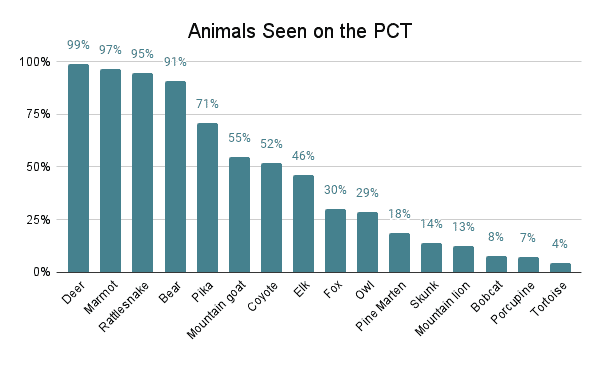
Support the Survey
Every year, I get a lot of people asking how to support the surveys. Beyond sharing them with your close-knit bubble of weird hiker friends, the best way to support the survey is to contribute via Patreon. You’ll get access to exclusive posts, discount codes, live streams, and super, extra cool stickers so that everyone will know how cool you are.
If you’re not into Patreon, that’s cool; you can Venmo @halfwayanywhere, Cash app $halfwayanywhere, or PayPal moc.erehwynayawflah@tcatnoc
This is not expected. The data collected in the survey will always be free and accessible to everyone who wants/needs it. Your support is much appreciated and helps pay the website (and survey) bills.



Pacific Crest Trail Survey Collection
Finally, another HUGE THANK YOU to all the hikers who completed this year’s survey, including (but not limited to): 50, (Mr.) Pringles, 0bo, 12 Pack, 2 Speeds, 50 Step, 8 Bucks, Addy Daddy, Admiral, Alan, All Day, All You Can Eat, Alpine, Amethyst, Anchorman, Animal Planet, Ant, Anthill, Anti-G, Antman, Apples, Ashed Potato, Ask Jeeves, Ass Muffin, Autopilot, Avo, Backflip, Backtrack, Bad Mouth, Bananas, Barefoot, Batman, Beast, Beeline, Bennett, Benny, Bermuda, Big Bear, Big Picture, Bilbo, Bionic Dan, Bleeder, Blind Rooster, Blisters, Bloom, Blue, Blue Heeler, Blue Raspberry, BlueBlaze, Blues Clues, Bob, Bodhi, Bondi, Bones, Boogie, Bookie, Booster Seat, Bopit, Bougie, Bounce, Breadcrumbs, Breezy, Brummel, Buckles, BUDDHA, Buddy, Buffalo R.O.I., Buffalo Strider, Bull’s Eye, Bungee, Butcher, Butterfingers, Butterfly, Butterscotch, Caboose, Caesar, Calculator, Camel, Cameraman, Camo, Can Opener, Caps, Captain, Captain Fantastic, Captain Something, Carmen San Diego, Cat Nap, Caterpillar, Celeb, Certified, Champagne, Charles, Cheery-O, Cheese, Cheeto Taquito, Chef, Chewy, Chicken Clock, Chico, Chips, ChooChoo, Chudy, Clash, Classic, ClickClack, Clip, Coach, Cobbler, Coinflip, Cold Stone Jesus, Commando, Conductor, Cookie Monster, Cool Beans, Cool Trails, Copper, Copter, Corky, Corndog, Courier, Cowbell, Cream Cheese, Crime Scene, Crocfire, Crocs, Crooked, Crow Boy, Cruise Control, Crunchy, Cucumber, Cuppa, Cuz, d20, Daddy Long Legs, Dairy Queen, Daisy, Danger!, Day Hiker, Daypack, Deadlift, Death Trap, Denali, Detour, Dexter, Diamondback, Diesel, Dine N Dash, Dino, Dirt Magnet, Doctor Za, Dogboy, Doggy Bag, Donuts, Double D, Double Shot, Down Dog, Dr. Taser, Dumbo, Dusk, Dusty, Dutchess Reservoir of the White Finnish Blood, Eagle Claw, Eagle Eye, Early Bird, Earlybird, Easy, El Chapo, Electric car, Encore, Energizer, Epic, Epiphany, Everlong, Excel, Exhale, EXODUS, Facilitator of Fun (Foff), Fanny Snacks, Fanta Bandit, Fast Lane, Fat Dog, Favorite, Feels, Fenway, Ferrari, Field Guide, Field Trip, Fifty Shades, Fireman, FJ, Flæsh, Flash, Fly By, Flying Sombrero, Flyswatter, Foamy Fingers, Follow-Up, Footrest, ForeRunner, Forklift, Foxtrot, Foxx, Foxy Bottles, Fozzie Bear, Free Refill, Frito, Frosty, Full Moon, Fun Fact, FUN FACT, Gaia, Galileo, GameShow, Gandolf, Garbage Woman, Garnet, Gazelle, Geared Up, Gearhead, Ghostface, Giggles, Give me one, Givn’R, Glide, Glowstick, Gnargret, Goldfish, Goldy, GoodFoot, Grandmaster, Grandpa, Granny, Grant Funded, Gravity, Green Thunder, Greens, Ground Bees, Gumby, Gummy Bear, Gunga Din, Haiku, Half & Half, Hamburglar, Han Solo, Hand Party, Handy, Happy Ending, Harry Pesto, Hawkeye, Head First, Health King, Heat, Hedwig, Helium, Hell Bent, Hide n Seek, Highlander, Highlights, Highrise, Hillgoat, Hitch, Hobbit, Hobble, Hooligan, Host, Houdini, House Fire, HQtie, Huh’, hundie, Hustle, Hype Man, Icky, Indiana Joe, Indy, Insight, Intrepid, Irish, Irwin, Izzy, Jane Doe, Javelin, Jazz, Jeff, Jeffrey Pine, Jive Turkey, JJ (give away), Jukebox, Jumbo, Daddy Long Toes, Jupiter, Just Patrick, Just Steve, Kansas Express, Karma, Kedger, Kegger, Kickstand, Killdeer, Kimche, Kismet, Kitty Hawk, KJ, Knuckles, Kool-Aid, Laces, Landmark, Late Bloom Hiker, Late Start, Lavender, Lazerkiwi, Lentil, Leuko, Lifesaver, Lightning, Lightning Rod, Liking It, Lil Bo Peep, Lil Slurp, Lily, Lion, Little foot, Little Plover, Little Stone, Lively, Loko, Lone Wolf, Loo, Looper, Lost & Found, Lost Boy, Lothar, Low Range, Lucky, Lucky Loser, Lumber & Jack, Lumos, Macgyver, Malto, Mama Bear, Maplefrog, Marathon Man, Mariachi, Maverick, Max, Meat Hands, Medicine Woman, Merlin, Mermaid, Merman, Messiah, Meth Trout, Metric, Metrick, Miles, Milk, Milkman, Milkshake, Mintea, Miso, MissileToe, Mitty, Mogul, Monster, Monte Cristo, Moo!, Mooch, Moon I Win, Morph, Mouse, Mowgli, Mr Bean, Mr. Clean, Mr. Smiley, Mr. Tidy, Mtn Goat, Mudslide, Mugs, Mumble, Muppet, Nat Geo, Natty G, Neighbor, Nemo, Nemophilist, Ninja, No A T, No Knife, No Poles, Noodle, Nope!, Nordic Jam, NoSeeUm, Not Sure, Nudist, Nugget, Nunyabizness, Nutcracker, OAKA, Old Bull, Old Weezer, Old Yeller, Onward!, Opportunity, Orange, Orange Crush, Out Loud, Over the Hill, Overdue, Overshare, Oyster, Pancake, Panty Pirate, Paparazzi, Pappa Appa, Patches, Peanut, Pebbles, Pedi-Cure, Pepsi, Permafrost, Pharmacist, Phoenix, Piano Man, Pick, Pickles, Piecemeal, Pierre, Pilot, Pine Nut, Pink Panther, Pioneer, Pippin, Pirate, Pitstop, Plank or Westy, Poodle bee, Popeye, Poppins, Pops, PopUp, Possibly, Potions, Potluck, Pre Pack, President, Prism, Puffy P, Purple Joy, Queen Bee, Queen of Hearts, Quick Oats, Quickstop, QWERTY, Radagast, Ragnar, Ramen Bitch, Raptor, Rapunzel, Rascal, Rat Trap, Ravioli, Raw Dog, Reaper, Recipe, Red, Red Bull, Red Panda, Reds, Reverend Al, Rhino, Rise-n-Shine, River, Rizz, Road Rash, Robin, Robinhood, Robo, Rock Solid, Rocket, Rocks, Rocky, Rogue, Rookie, Ruddy, Runway, Sabotage, Safari, Sage, Sail, Salmon, Sani, Santiago, Sassenach, Sassy, Sassy Finger, Sauce, Saved It, Scar, Scavenger, Schmutz, Scrum, Seabiscuit, Sensei, Serious, Shade Finder, Shaman, Shepherd, Sherpa, Sherwood, Shield, Shit Show, Shotgun!, Shotput, Shuffles, Side Quest, SignTap, Silver Fox, SixEyes, Sketch, Sketchy, Skippy, Skratch, Sky, Slalom, Slapshot, Sleepless, Sloppy Joe, Smiley, Snack Hole, Snack Master, Snake Charmer, SnekByte, SNOOZE, sobo, Sonic, Sorry?, SOS, Soulslosher, Sound Box, Spaceman, Spanx, Spare Change, Sparkplug, Speaker/Derailer, Speedskirt, Spice, Spidey, Spigot, Splash, Splinter, Split Pea, Sponge, Spoons, Spot, Spreadsheet, Sprinkles, Sprocket, Squid, Squiggles, Sriracha Rocket, Stagecoach, Starfish, Status Report, Steady, Stealth, Steamy, Steelhead, Sticks, StillRob, Stinger, Stitch, Stone Cold Cheese Austin, Stonie, Storyteller, Stranger, Straps, Stretch, Strider, Stripes, Strix, Stumbles, Subtle, Suffer Twice aka Rude, Sugar Daddy, Sunfish, Sunflower, Sunshine, Sure Does, Survivor, Sushi, Susi, Swami Bittergoat, Sweatsuit, Sweeper, Sweet Greens, Sweet Kale, Swell, Swifty, Swig, Taco, Tadpole, Tail Wind, Talkie Walkie, Talks Alot, Tap Tap, Tapatio, Tapper, Team Johnson, That Brunette, The Colonel, The Director, The Duchess, The Godfather, The Man, The Monarch, Thomas, Three Dinners, Tic Toc, Tigger, Tinkerbell, Tony, Tortoise, Totaled, TouchTunes, Tough Enough, Tour Guide, Toxic, Trail Crew, Train, Trainwreck, Trash Balloon, Trash Can, Trashman, Trashpanda, Tree Up, Treebeard, Treehugger, Trickshot, Trigger, Trinity, Trip hazard, TripppleCheck, Trippy Bottles, Trips, Trooper, Tropical, Troubadour, Trout, Tumbleweed, Tummy, Tuna Juice, Turq, Turtle, Twiggy, Twizzler, Two-Mile, UB, Uber, UConn, Unfiltered, Velcro, Verizon, Vibes, Viking, Viking Chief, Waffles, Waldo, WalkItOff, Wallflower, Walmart, Warranty, Warrior, Water Snob, Watering hole, Weepy, Wet Wipe, Wheat, Whiskey, Whisper, Whistler, Whistles, White Wolf, Wicked Dinger, Wings, Wingspan, Wizard, Womble, Wonderwall, Woods, Wrong Way, YARDSALE!, YOM, Youngblood, Your Highness, Zacuum, Zelda, Zesty, Ziploc, Zippo, and Zoom
If you have any feedback, comments, suggestions to improve the survey, or data you would like to see in future posts or surveys, leave a comment below and let me know!
Sign Up for Next Year’s Survey
Affiliate Disclosure: This page may contain affiliate links, which means I may receive small commissions for purchases made via these links at no additional cost to you. This helps pay the bills and keep the site up and running. Thank you for your support!
